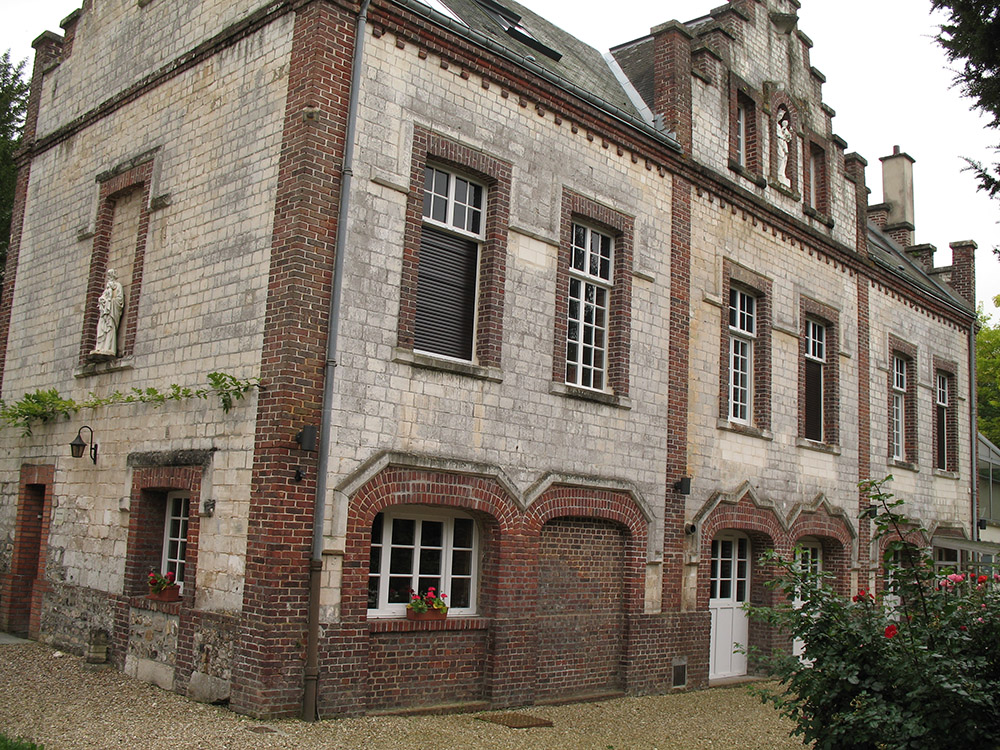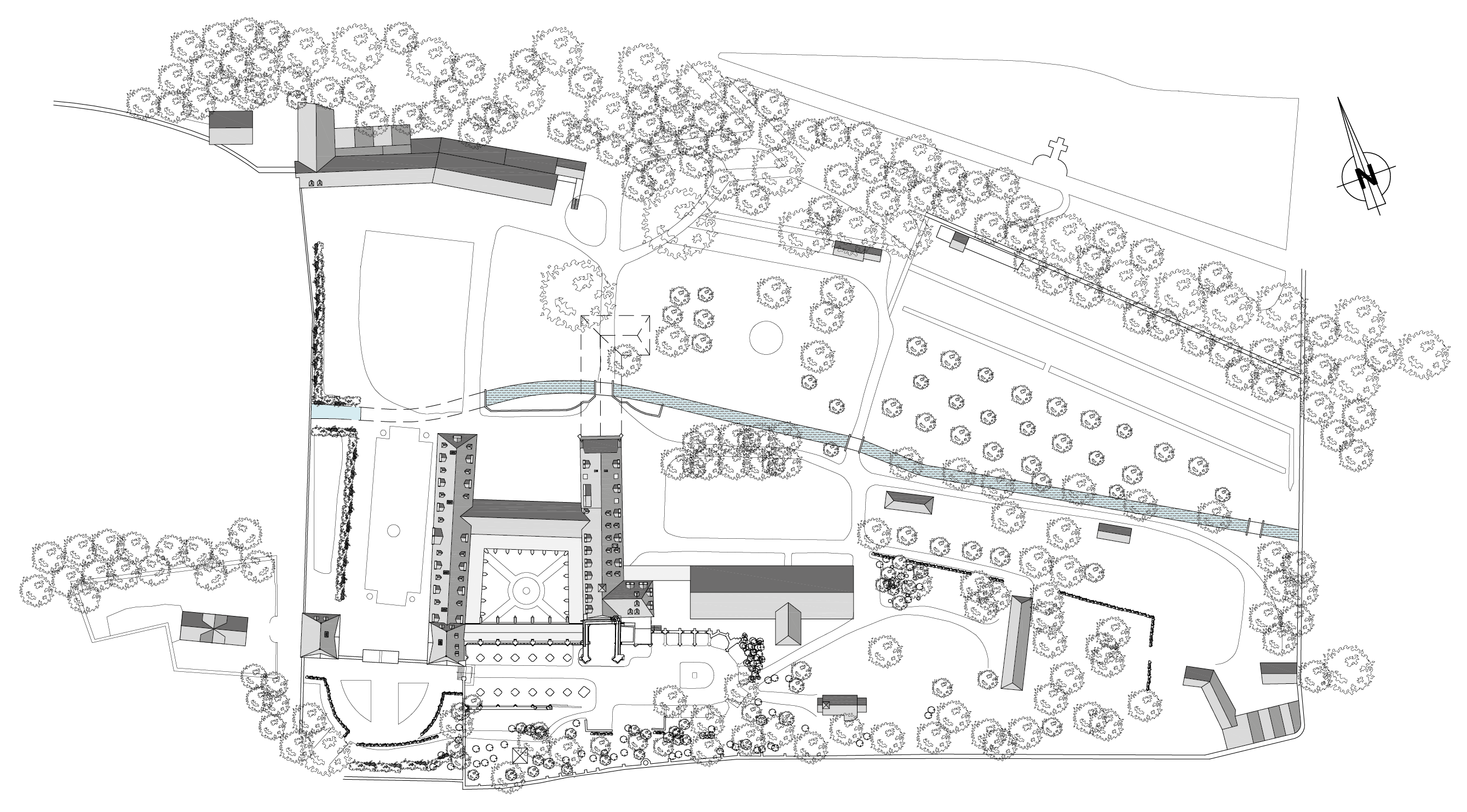The Abbey
Founded by Saint Wandrille in 649, our abbey has a remarkable spiritual heritage. Indeed, 40 monks from our community are honored as saints and are the object of liturgical worship, which is an immense honor, but also a great demand of sanctity for ourselves.
Fontenelle’s Saints
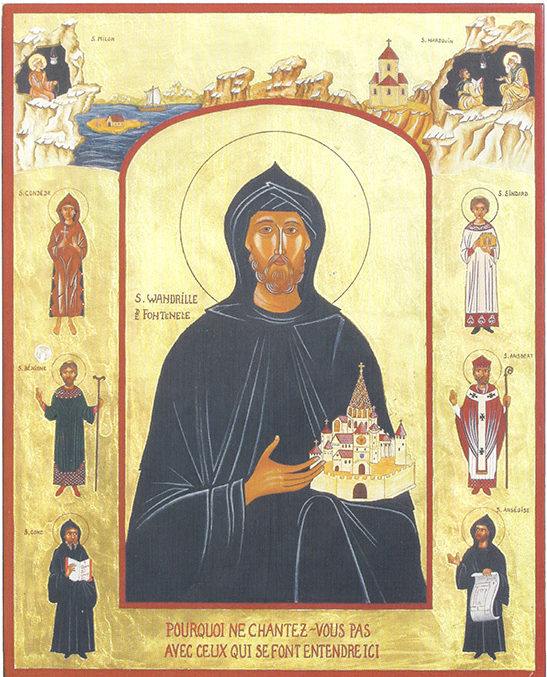
- + Our Blessed Father Saint Wandrille
- + saint Sindard
- + saint Agathon
- + saint Érembert
- + saint Désiré
- + saint Genès
- + saint Condède
- + saint Lantbert
- + saint Gond
- + saint Ansbert
- + saint Vulfran
- + saint Hildebert
- + saint Herbland, ou Hermeland
- + saint Bain
- + saint Gennard
- + saint Bagga
- + saint Bénigne
- + saint Hugues
- + saint Landon
- + saint Ermier
- + saint Milon
- + saint Austrulf
- + saint Wandon
- + saint Ravenger
- + saint Gervold
- + saint Hardouin
- + saint Trasaire
- + saint Anségise
- + saint Hérimbert
- + saint Éginhard
- + saint Foulques
- + saint Gérard the Ist
- + saint Gradulphe
- + saint Gerbert
- + saint Gontard
- + saint Gautier
- + blessed Louis François Lebrun
OUR BLESSED FATHER SAINT WANDRILLE
founder and first abbot, +668
celebrated on 22 July
SAINT SINDARD
monk and deacon, VIIth century
celebrated on 18 September
Our father Saint Wandrille sent him to Sainte-Eulalie in Bordeaux to meet with Saint Hildemarque, future abbess of Fécamp, and asked him to bring back relics of Saint Saturnin, bishop of Toulouse, and Saint Amans, bishop of Rodez. The remains of deacon Sindard are still believed to be in Gauville, hidden beneath the ruins and vegetation.
SAINT AGATHON
monk, + before 668
celebrated on 8 July
Disciple of saint Wandrille. Our Blessed Father indeed counted him among the saints; as he prayed, shortly before his last breath, he saw Agathon included in the choir of the blessed whom the Lord sent to meet him. With joy on his face, he invoked the name of this righteous man, whose praiseworthy life he had come to appreciate; hence the veneration paid to Agathon in our monastery, as attested by several ancient documents.
SAINT ÉREMBERT
monk, bishop of Toulouse, + 671
celebrated on 14 May
Born of noble parents in Filliancourt, near Le Pecq, he was chosen by the Lord and by order of Clotaire III to occupy the episcopal see of Toulouse. After the reshuffling of territories that took place when Dagobert II was removed in 661, the man who represented Neustria on the banks of the Garonne had to return to the banks of the Seine.
Érembert lived, perhaps for several years, with his brother Gamard and his nephews Nammachus and Zachée in the monastic community of Filliancourt, before spending his final years in the abbey of Fontenelle under the government of Saint Lantbert. His body was laid to rest first in St. Paul’s Basilica, then in St. Peter’s Church, where many came to ask God for his intercession.
SAINT DÉSIRÉ
son of Saint Waninge, founder of Fécamp, 7th century
celebrated on 18 December
SAINT GENÈS
chaplain of Saint Bathilde, bishop of Lyon 680
celebrated on 3 November
Genès was a member of the clergy at the palace of Clovis II, where he was given the title of abbot. The king had attached him in particular to Queen Saint Bathilde, whom he helped in her devotions and good works, looking after poor priests and monasteries.
SAINT CONDÈDE
monk, abbot of Belcinac, + 680
celebrated on 21 October
Born in Britain, he crossed the sea to lead a more austere life and settled in a solitude near Saint-Valéry; then attracted by the reputation of Abbé Lantbert, he lived for years at the Fontenelle monastery.
But not understanding religious life without preaching and example, he withdrew to an island in the Seine called Belcinac, to the west of Caudebec; there he built two churches, one to the Virgin, the other to the apostles Peter and Paul, receiving the many faithful who crossed the river to see and hear our hermit.
Concède was buried in the Church of the Holy Apostles, but the “barre”, since called “mascaret” (tidal bore), invited the brothers to transport the Blessed’s body to Fontenelle. In 1027, his remains were joined to those of Saint Erembert.
SAINT LANTBERT
2nd abbot, bishop of Lyon, + 688
celebrated on 14 April
When he entered Fontenelle, he and his father gave the abbey considerable property in the Ternois region, which formed the basis of Saint-Wandrille’s fortunes in this region. As for the Donzère estate, located opposite the episcopal city of Viviers on the banks of the Rhône, this was a new favor from Thierry III, which the king may have granted to Lantbert to provide for the monastery’s oil needs.
Finally, the travels required by this foundation probably brought the Abbé de Fontenelle into contact with the Lyon region, and led to him being called to the see of Saint Pothin.
In the words of one of his historians, he was a first-class administrator, who, in all the circumstances in which he had to appear, always succeeded admirably through his qualities of thoughtful audacity and method. In Fontenelle, he remained the personification of discipline, in all its formative and fruitful aspects.
The Hieronymian martyrology attests that he was venerated shortly after his death.
SAINT GOND
founder with Saint Wandrille, then abbot of Oye, + 690
celebrated on 26 May
Gond is considered a nephew of our father Saint Wandrille, in the very words of the Vita sancti Wandregisili. In fact, Saint Gond’s mother, whose name has not come down to us, was a sister of Waugise, Wandrille’s father; but beyond the misuse of the term “nephew” by the Saxons, the two cousins, with the approval of Ouen, bishop of Rouen, were able to build the Fontenelle monastery in the forest of Roumare, in the year of our Lord 649.
Wandrille sent him to Rome with the mission of bringing back relics of the holy apostles Peter and Paul and the holy martyrs Lorenzo and Pancrace, as well as books of Sacred Scripture and Pope Gregory.
Around 662, after dedicating himself at Fontenelle, Gond retired forever to the solitude of Oye, in Champagne. He died on May 26, around the year 690. His body was solemnly recognized in 1621; in 1936, the bishop of Châlons-sur-Marne donated two relics of the saint to us.
Saint Gond is still honored today in eastern France, in Verdun and Châlons-en-Champagne, in Langres and Besançon; over the centuries, he was especially honored in Saint-Wandrille, until the French Revolution. Given this cult and the essential role played by Saint Gond in the early days of our monastery, the Fontenelle monks are once again celebrating the merits of our Blessed.
SAINT ANSBERT
3rd abbot, bishop of Rouen, + 695
celebrated on 9 February
Designated by our father Saint Wandrille as one of his immediate successors, he also assumed, full of merit, the office of bishop of the city of Rouen after the death of Saint Ouen, in 684.
A victim of jealousy, Ansbert sought hospitality with the monks of Hautmont, in the diocese of Cambrai. He died in exile in the year of our Lord 695, but his remains were brought back to Fontenelle. Hildebert, the monastery’s new abbot, went to meet them with the crowd of faithful from the diocese and the abbey’s monks; having received the precious burden, he devoutly carried out the entire funeral ceremony.
The remains of Saint Ansbert were placed in the church of Saint-Paul, then nine years later, in 704, in the church of Saint-Pierre. Later, for fear of the Normans, St. Ansbert’s relics were transported to Ponthieu and finally to Ghent’s Mont-Blandin, before they were destroyed by Calvinists in 1578.
Perhaps at the beginning of the 9th century, the monk Aigrade began to collect the main features of Saint Ansbert’s life, given the great influence and veneration this latter enjoyed.
The cult of Saint Ansbert was constant in our monastery throughout the Middle Ages. Today, we like to remember St. Ansbert’s zeal for maintaining the monastery’s vineyard on the Saint-Saturnin hill.
SAINT VULFRAN
monk and bishop of Sens 697
celebrated on June 1st
Vulfran was a monk at our monastery and archbishop of Sens. From his long stay in this world, and doubtless also from a special impulse from the Lord, he had retained a taste for the apostolate; imitating the Celtic religious, he was at the forefront of preaching the Gospel among the Frisians. After preaching the good news for five years, Saint Vulfran returned to Fontenelle to live in seclusion and prepare for death.
Since the 11th century, the venerated remains of the Blessed Vulfran have been the object of assiduous worship, distinguished by innumerable miracles which, until the Wars of Religion, it seems, brought streams of devout pilgrims every five or six years to the feasts known as Le grand Pardon de saint Vulfran.
HILDEBERT
4th abbot, + 701
celebrated on February 18
It was Hildebert who, shortly after 684, welcomed the future Saint Vulfran and encouraged him in his plans to evangelize the Frisians, granting the missionary the resources and auxiliaries he desired. Some ten years later, he received Wandon, a native of Vimeu, and shortly afterwards Bénigne, two future abbots of the monastery.
Abbot Hildebert was honored by the cult of the saints, and did not have to suffer from the controversy that arose among the Maurists on this subject; at that time, moreover, his relics were kept in plain sight in a shrine close to the altar.
SAINT HERBLAND, OR HERMELAND
monk, abbot of Indre 720
celebrated on March 16
Born in Noyon to a distinguished family, he was cupbearer to King Clotaire III, and left the court to devote himself to God. He entered Fontenelle around 668 and was ordained priest by Saint Ouen shortly after his profession. He was sent with twelve religious to the bishop of Nantes, who established them on the island of Indre, two leagues from the city.
After a long period of governing and building up his community, Hermeland left his position and spent the rest of his life in a small oratory he had built in honor of Saint Leger.
He was buried in Saint-Paul church, near the oratory of Saint-Wandrille, and raised from the ground fifteen years later. Most of his relics were transported to Loches in the 9th century; half a tibia was donated to us in 1936. Several churches in Brittany are under its protection; Rouen once had one near the cathedral.
SAINT BAIN
bishop of Thérouanne, 5th abbot, + 710
celebrated on June 20
He was a monk at this monastery, then bishop of Thérouanne, around 698. After a twelve-year episcopate, Bain left his diocese to return to Fontenelle Abbey, where he became the fifth abbot. The author of the Gesta lists the numerous donations that King Childebert granted him, including the monastery of Fleury in the Vexin, the church of Poses in the diocese of Évreux and the fisheries of Pecq, near Poissy.
On March 31, 704, Bain transferred the bodies of Saints Wandrille, Ansbert and Vulfran from St. Paul’s Basilica to St. Peter’s Church.
Saint Bain died six years later. His name is inscribed in the Hieronymian martyrology.
SAINT GENNARD
vidame of the church of Rouen, abbot of Fly 719
celebrated on April 6
He was first vidame of the Church of Rouen, attended the council held in 689 by Saint Ansbert, then bishop of that city, and followed him into exile in Hainaut. Having become Abbot of Flay, he soon handed over his abbey to his relative Saint Bénigne, and died at Fontenelle, where he wished to be buried alongside Saint Ansbert.
SAINT BAGGA
monk 720
celebrated on June 5
Originally from Great Britain, he lived at Fontenelle, where for many years he led a life of irreproachable regularity, according to his abbot Saint Bénigne. Indeed, the Gesta abbatum Fontanellensium reports that the holy abbot Bénigne sighed at length as Christ’s servant left this earth; inspired by the Spirit of God, he spoke these words aloud: “O Bagga, valiant standard-bearer of Christ’s militia, you now happily receive the wages of your labors; pray to the Lord Jesus, too, that we may merit to enjoy eternal companionship with you in the company of the elect”.
SAINT HUGUES
bishop of Rouen, Paris, and Bayeux, 8th abbot, + 732
celebrated on April 9
Son of Drogon and cousin of Pepin the Short, he was raised by his grandmother, Saint Ansflède, who instilled in him a contempt for the world. Appointed bishop of Rouen in 723, he was also entrusted with administering the dioceses of Bayeux and Paris, and the abbeys of Fontenelle and Jumièges, not out of ambition or interest, but in accordance with the custom of the princes of the time, despite the canons of the Church.
In addition to the goods Hugues gave to the Fontenelle abbey, he bequeathed a gold chalice with a large paten, a gold turret and a jeweled shrine containing the relics of several saints.
His body was deposited at Jumièges in the church of Notre-Dame, then transferred in the 9th century to the priory of Haspres in the Cambraisis region. Since 1897, Saint-Wandrille has been in possession of the Blessed’s humerus, which came from Jumièges.
SAINT LANDON
9th abbot, archbishop of Reims 735
celebrated on January 16
He served as bishop in the diocese of Reims, before obtaining the Fontenelle abbey. At the court of Charles Martel, he received a second benefice, that of Saint-Saëns in the Varenne valley. In addition, the prince confirmed the monastery’s assets, and the all-powerful Mayor of the Palace specified that he was taking the abbey under his special protection, from all civil and religious authorities. Abbé Landon governed Fontenelle for three years and then joined his fathers. His name is inscribed in the Hieronymian martyrology.
SAINT BÉNIGNE
6th abbot, + 724
celebrated on March 22
He was a monk, then Abbot of Fontenelle, who prayed that he would be granted the company of the righteous in eternity. Driven out of his abbey for taking sides in the fight between Charles Martel and Rainfroy, he took refuge in Flay. A few years later, he was called back to Fontenelle. Under his rule, the abbey received a large number of possessions, but above all, it counted religious distinguished by their holiness, including Rothmond, father of Saint Milon, Milon himself and the priest Bagga.
SAINT ERMIER
prior 745
celebrated on Septembre 24
Monk and prior of this place “loving and favoring the monastic rule and austere observance”, says the chronicler. Even under the sad abbot Teutsinde, it was possible for him to build a church, probably for the faithful living around the abbey. It was built at the south-western corner of the buildings, at the highest point of the complex, and perhaps for this reason, dedicated to Saint Michael. Rebuilt in the 11th century, it has been the parish church ever since. Having completed his career, Ermier was buried in Saint-Pierre church, in front of the cloister door.
SAINT MILON
monk and hermit 730
celebrated on August 18
With the permission of his abbot Saint Bénigne, Milon retired with his father Rothmond, to lead an anchorite life, while his mother Gisla entered the monastery of Logium near the Seine. Our saint’s hermitage, still known today as “Grotte à Milon”, was located near the mouths of the Rançon and Fontenelle rivers; carved out of solid rock, it could hold around twenty people. There, Milon watched over the stormy abyss that lay at his feet, battling the evil spirits of the air that capsized the frail skiffs navigating the river; at the foot of the rock, he celebrated mass in the small chapel where he also received pilgrims. Finally, wanting to live by the work of his hands, he planted and cultivated vines on the hillside. After a long practice of good works, he gave up his soul to the Lord.
SAINT AUSTRULF
13rd abbot, + 753
celebrated on September 16
In charge of temporal affairs during St. Wandon’s lifetime, he had obtained a diploma from Pepin granting the abbey regalian rights over its tenants, and it was under his abbatiate that possessions in the Cotentin region increased. In 753, the king’s favor obliged him to prepare for the arrival of Pope Stephen II in the Frankish states. Austrulf arrived in Agaune on his return from Rome, where he prematurely ended his diplomatic mission.
SAINT WANDON
7th abbot, + 754
celebrated on April 17
A native of the Vimeu region, he brought important estates with him when he became a monk. The fortunes of politics placed him at the head of the abbey, at the same time as Rainfroy showered him with favors; but the same fortunes, say Charles Martel, sent him into exile, eastwards, to the monastery of Saint-Servais in Maëstricht; he was to remain there for twenty-eight years, supporting himself through prayer and study. After this, Pepin the Short authorized Wandon’s return to the Caux region, where, despite his advanced age, the Abbot of Fontenelle was able to trace a path of intellectual development that ensured his lasting esteem and recognition. Seven years after his return, he was deprived of his sight, so without slackening in his good works, he recommended himself to Christ by fasting, watching and praying. His body was buried in Saint-Pierre church, along with the blessed confessors Wandrille, Ansbert and Vulfran.
SAINT RAVENGER
monk, bishop of Sées, + 750
celebrated on February 3rd
SAINT GERVOLD
monk, bishop of Evreux, 15th abbot, + 807
celebrated on June 14
Born of noble parents, he entered the palace and, after taking Holy Orders, became chaplain to Queen Bertrade. Charlemagne called him to the bishopric of Évreux, and even entrusted him with several missions in England. In 787, our Blessed was Abbot of Fontenelle. “He found a great deal of ignorance,” explains Dom Abraham Féray, “and in order to chase it away like the plague from the monasteries, he instituted a school to teach the monks letters and singing. He also built a new infirmary, sacristy and kitchen, and covered the churches of Saint-Pierre, Saint-Paul and Saint-Michel in lead. Finally, he obtained from the Emperor a privilege to recover the monastery’s property that had been alienated.
SAINT HARDOUIN
monk and hermit, + 812
celebrated on April 20
Monk from this monastery, to whom ancient documents give the title of deacon or priest of Saint-Saturnin. The contemplative life he enjoyed led him to live in solitude in the hermitage that our father Saint Wandrille had dedicated to the holy martyr, on the hillside to the north of the abbey. Ignoring idleness, he taught many of his disciples the rules of arithmetic and computation. What’s more, he taught them the art of writing, in which he had become a master, using caroline mixed with Anglo-Saxon notes, as evidenced by manuscripts now preserved in Rouen, Berlin and Coblence, bearing witness to what he bequeathed to his monastery.
SAINT TRASAIRE
16th abbot, IXth century
celebrated on March 16
Abbot of this monastery, he obtained from Louis the Pious, in the second year of his reign, a decree confirming the privileges granted to the abbey by his predecessors. With his kind permission, Abbé Trasaire was able to return to his homeland, and Duke Sigon of Benevento, whom he had baptized, received him with honor. After which, back at Fontenelle, he resigned his abbot’s office and spent the rest of his life in sanctity. At the time of the Congregation of Saint-Maur, his relics were still displayed for the veneration of the faithful in a shrine placed on the main altar.
SAINT ANSÉGISE
19th abbot, + 833
celebrated on July 20
Born around 770, Anségise was of Frankish origin; he retired to Fontenelle near his relative Gervold, then abbot, who conferred the clerkship on him. Charged by Charlemagne with administering the two monasteries of Saint-Sixte near Reims and Saint-Menge near Châlons, he then became abbot of Saint-Germer in the diocese of Beauvais; in 817 he was appointed abbot of Luxeuil, and of our monastery in 823. Together with his fellow members of the old colombian monastery, he revived the monastic spirit, expanded the library, restored several buildings and built new ones, including the Chapter House to the north of St. Peter’s church, the oldest chapter house mentioned in the texts, according to scholars. The ninth-century Gesta describes its use as follows: “It is here that the brothers are accustomed to assemble when they have to deliberate on some matter; it is here that, every day, the divine law is read from a lectern, and what is commanded by the authority of the Rule is indicated”. In addition, Anségise ensured the regular upkeep of the monasteries, carefully settling the royalties owed by each farm. Last but not least, he is the author of the oldest collection of Capitularies of Charlemagne and Louis le Débonnaire.
SAINT HÉRIMBERT
22nd abbot, + 850
celebrated on September 11
Succeeding Blessed Foulques, he governed the abbey for over four years, and was able to stand up to the Vikings who were ravaging the country at the time. In due course, he sent help to King Charles the Bald, who was besieging the rebellious Toulouse.
SAINT ÉGINHARD
18th abbot, + 840
celebrated on May 18
Raised at Charlemagne’s court, he later became the emperor’s secretary. Louis le Débonnaire showered him with favors, and it was thus that, according to the religious legislation of the time, he obtained several ecclesiastical benefices, the abbeys of Fontenelle, Saint-Servais de Maëstricht, Saint-Pierre du Mont-Blandin, Saint-Bavon de Gand and Saint-Maur des Fossés. Finally, he bid farewell to the world and founded the monastery of Seligenstadt on the Main, in honor of the holy martyrs Marcellin and Peter. During his five-year abbatiate at Fontenelle, he and Benoît de Saint-Maur-des-Fossés worked hard to encourage a reform of monastic life. Called to other dignities, he placed his crosier in the hands of Saint Anségise.
SAINT FOULQUES
21st abbot 845
celebrated on October 10
We read that in his time, the Danes, or Normans, swept through Neustria like a plague. On May 24, 841, the abbey’s local superiors, acting in place of the abbot detained at court, contacted the Viking Oscar commanding the flotilla to negotiate a ransom. Tired of looting, they settled for six pounds of gold for the monastery itself, according to the chronicle. Three years later, Blessed Foulques received his eternal reward; he had governed Fontenelle for eleven years, six months and twenty-six days.
SAINT GÉRARD the Ist
30th abbot, + murdered in 1029
celebrated on November 29
In 1029, on the night of Saturday to the first Sunday of Advent, the martyrdom of the holy abbot Gérard, murdered by a criminal hand, while the man of God was taking his rest “after the work of the hands, fasting and prayers of custom”. A model of observance, gifted with heavenly favors, Saint Gérard, at the request of Duke Richard, had to give up the government of the priory of Crépy-en-Valois, take over that of Fontenelle and raise this monastery from its ruins. He rebuilt St. Peter’s church, and it was during this work that the remains of St. Vulfran were discovered and placed in a silver cistern. He himself was buried with honor at the entrance to the Chapter he had built. In 1671, a lead blade bearing the inscription: “Hic requiescit Abbas Gerardus… ab injusto injuste interfectus” was found in his grave.
SAINT GRADULPHE
31st abbot, + 1048
celebrated on March 6
Abbot of this monastery for 19 years. While still dean, he was entrusted with building the abbey of Mont-Sainte-Catherine, near Rouen. In 1031, he had the new church of the Saint-Wandrille monastery, rebuilt by his predecessor Saint Gérard, consecrated. At his request, Duke William restored the island of Belcinac and donated four churches to England. The holy abbot was also advisor to Onfroy de Vieilles, lord of the castellany of Pont-Audemer, with a view to founding a monastery on the Préaux lands; in fact, he sent him monks, first Eymard and then Ansfred, who was to become the first abbot.
Despite the devotion of the faithful to the remains of Saint Gradulphe, his body was burned by the Calvinists; nevertheless, the people continued to pray before his tomb.
SAINT GERBERT
33rd abbot, + 1089
celebrated on September 4
Originally from Mainz, a monk in Florence, then in Fécamp with Saint Maurille, and renowned for his holiness, Gerbert was called to Fontenelle by William the Conqueror, in order to give spiritual renewal to monastic discipline. Religion and charity shone in Gerbert; his experience was great in all things and his zeal for Opus Dei (religious services) unfailing. Attached to Saint Anselme, with whom he may have stayed at Le Bec, he trained several renowned abbots at his school: Godefroy, the first abbot of Fontenay; Saint Gontard, the illustrious abbot of Jumièges; Ingulphe, whom William put in charge of Croyland; the venerable Gauthier, abbot of the Sainte-Trinité du Mont-Sainte-Catherine near Rouen; and another Godefroy, who was abbot of Saint-Pierre de Préaux. Saint Gerbert was buried in the Chapter. His remains rested there until 1672, when the said Chapter was destroyed.
SAINT GONTARD
abbot of Jumièges, + 1095
celebrated on Novembre 26
As chaplain to William the Conqueror, he entered our monastery, bringing with him the English possessions bestowed on him by the duke-king, the churches of Whitchurch canonicorum, Burton Bradstock, Sherston and Towcester. He became prior of Saint-Wandrille, but soon afterwards was elected abbot of Jumièges, carefully dispensing spiritual nourishment to the sheeps entrusted to his care. He attended William the Conqueror on his deathbed, concerned with both the prince’s spiritual and bodily salvation. After 17 years as governor of Jumièges, Gontard was ordered by the archbishop of Rouen to attend the Council of Clermont convened by Pope Urban II. Stricken with fever, he received the last rites from Gilbert, bishop of Évreux, and breathed his last in peace. It wasn’t long before he was considered a saint, and his liturgical cult continued in our monastery well into the 18th century.
SAINT GAUTIER
32nd abbot, + 1150
celebrated on August 13
English by birth, he illustrated our monastery with the brilliance of his virtues. He was indeed a man of enlightened counsel, attentive to the maintenance of discipline; it was to him that Popes Innocent II and Eugene III granted the diplomas confirming and safeguarding the abbey’s possessions.
BLESSED LOUIS FRANÇOIS LEBRUN
martyred on the pontoons of Rochefort, +1794
celebrated on August 20
Born in Rouen in the parish of Saint-Herbland, he made his monastic profession at the age of nineteen on June 10, 1763, in the congregation of Saint-Maur, and was ordained priest in 1771 in the chapel of the archiepiscopal palace of Rouen by Cardinal de La Rochefoucauld. After holding a number of posts in monasteries in the province of Normandy, Dom Le Brun arrived at Saint-Wandrille in December 1788, when the then prior chose him as senieur (dean). After the Revolutionary law of February 1790 abolishing religious orders, Dom Le Brun, wishing to continue leading a monastic life, withdrew to Jumièges and then to Le Bec, which outlasted Saint-Wandrille, and then moved to Rouen. Three years later, having refused to take the “Liberty-Equality” oath, and to avoid his family suffering for having taken him in, he surrendered, was arrested and sent to the Saint-Vivien prison. On March 21, 1794, it was the departure to the pontoons of Rochefort. After four months on board the “Deux-associés”, a ship dedicated to transporting slaves, Dom Louis-François Le Brun went ashore; always practicing the virtues of piety, gentleness and modesty, he died a confessor of the faith, a priest to the end, faithful to the observance of ecclesiastical laws and attached to the holy hierarchy of the Church. He was beatified by Pope John Paul II along with many of his companions on October 1, 1995.
saint Wandrille
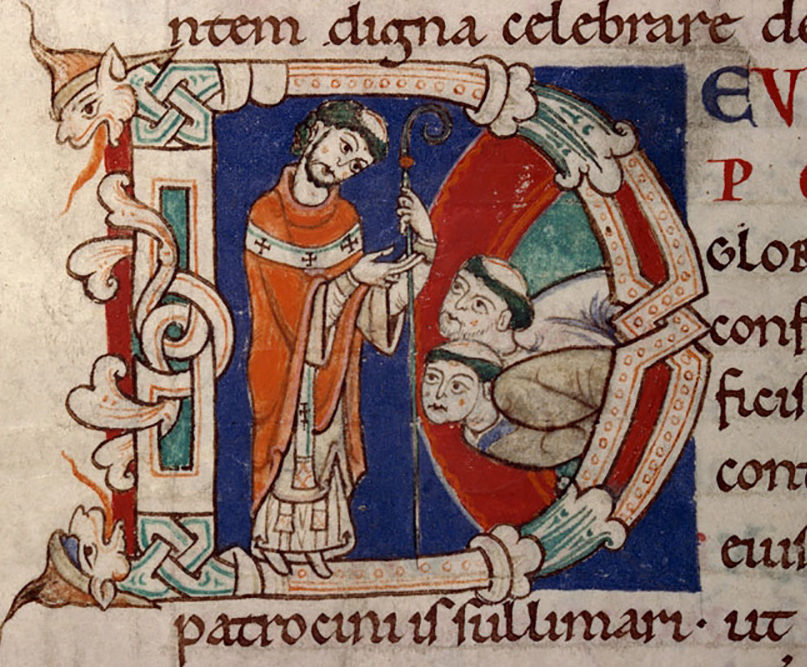
Saint Owen, Bishop of Rouen, former dignitary of King Dagobert devoted himself to monastic causism by helping both St. Wandrille to found the Abbey of Fontanelle and St. Philibert that of Jumièges. Illumination from the 11th century.
Saint Wandrille was a son of nobility from the Verdun region of France. Quite naturally, Wandrille enters the service of King Dagobert. He was a good Administer of the Royal Estates. He seemed most likely to have the highest destinies within reach.
In obedience to his parents, he gets married. However, both spouses aspire to another life that was dedicated to God. The wife, a very young woman, enters a monastery and Wandrille, after having distributed their goods to the poor, joins various hermits. A dream led him to go to Bobbio, an Italian monastery founded by Saint Columban. Wandrille stayed there about 10 years. Later, he went to other Benedictine monasteries, including Romainmôtier in Switzerland. He lived in community and practiced a more interior asceticism.
Having learned that his friend Dadon (Saint Audoen or Saint Owen) St. Owen had been appointed Bishop of Rouen, Wandrille came to join him. He was made subdeacon, deacon, then ordained as priest. Wandrille, the second to St. Owen evangelized the pagans, but this life did not suit him well. He yearned to find solitude again.
In 649, St Owen gave him the opportunity to settle in the valley of Fontanelle. On a marshy and wooded land bought by the young Gond, Wandrille’s nephew. The beginnings of life at the monastery were rough. The land was cleared, the marshes were drained, and even vines were planted near the Chapel of Saint Saturnin. Wandrille built a church dedicated to Saint Peter and oratories dedicated to Saint Paul, Saint Laurent and Pancrace. Soon his nephew Gond, judging his work finished in Fontanel, left him to lead the eremitical life in Champagne.
Wandrille died on the 22nd July 668.
chronology
Foundation of Fontenelle Abbey by Saint Wandrille.
His first successors, St Lantbert and St Ansbert, saw the community grow.
This period of prosperity reached its peak under the abbatiate of Anségise (823-833).
But Norman invasions continued to multiply.
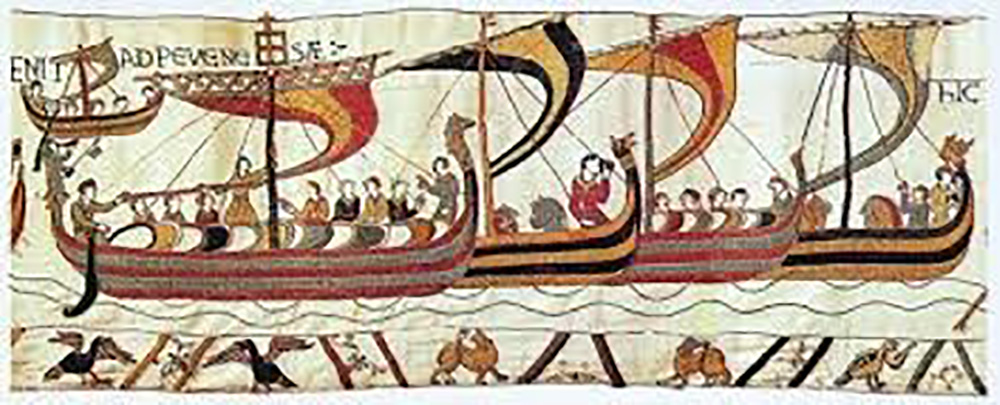
Sacking and burning of the abbey by the Vikings.
The monks had to leave, taking with them the relics of their saints.
First exile.
Return of the monks to Fontenelle, with Abbot Maynard de Gand. They set about rebuilding the monastery, which took the name of Saint-Wandrille. Various foundations were established, including Mont-Saint-Michel in 967.
The Hundred Years’ War began in 1337.
Concordat of Bologna between Pope Leo X and Francis I, who now decides on the appointment of abbots. The commendatory abbots were content to run the abbey in their own pecuniary interests, to the detriment of monastic life.
At a time when the abbey was already weakened, the Wars of Religion broke out.
The monastery was sacked by Huguenot troops.
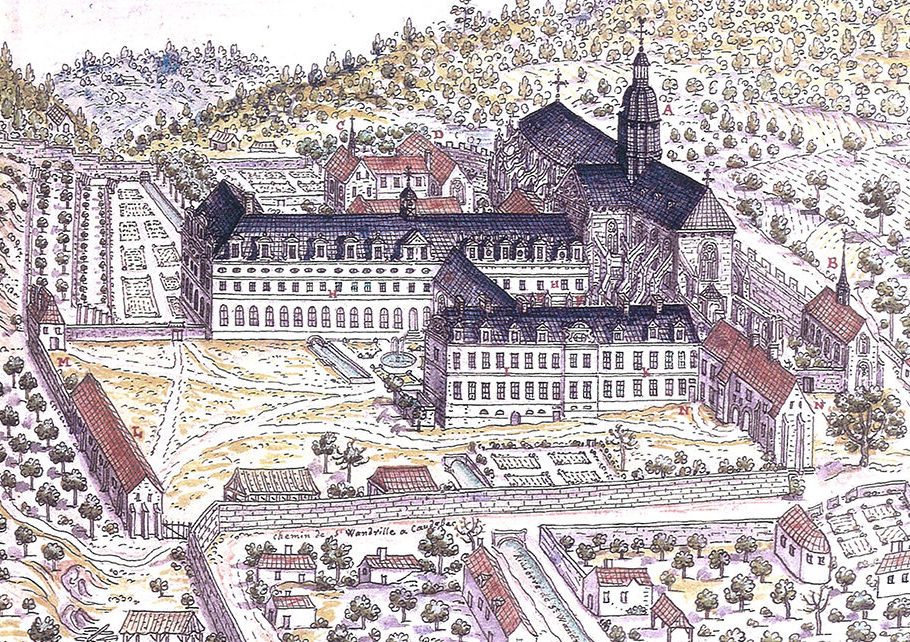
A few lesser Jumièges residents join the community of Saint-Wandrille to introduce the reform of the Benedictine congregation of Saint-Maur. This marked the beginning of a period of intense reconstruction and spiritual renewal. The abbey became a renowned center for philosophical and theological studies.
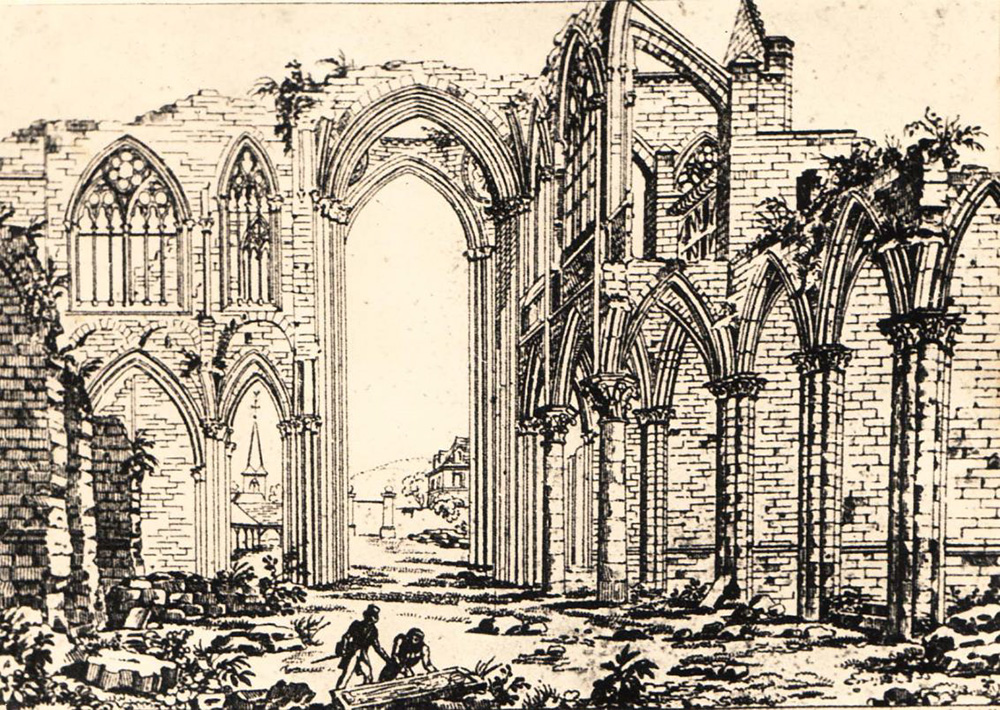
The French Revolution sounded the death knell for convent life. A monk, Louis-François Lebrun (beatified by John Paul II), dies a martyr’s death on the docks at Rochefort.
1791 : The monastery is sold as national property to Cyprien Lenoir, an industrialist from Yvetot. He set up a brass pin factory, followed by a tobacco factory and even a saltpetre and gunpowder workshop. He used the church as a stone quarry and traded in stones. On his death, his children set up a spinning and weaving mill.
1863 : The Marquis of Stacpoole acquires the monastery and the ruins of the church. He transforms the buildings into a “summer house” at great cost and expense.
When he decided to sell, talks began with the Abbé de Ligugé.
Monastic life resumes at Saint-Wandrille Abbey with a few monks from Ligugé.
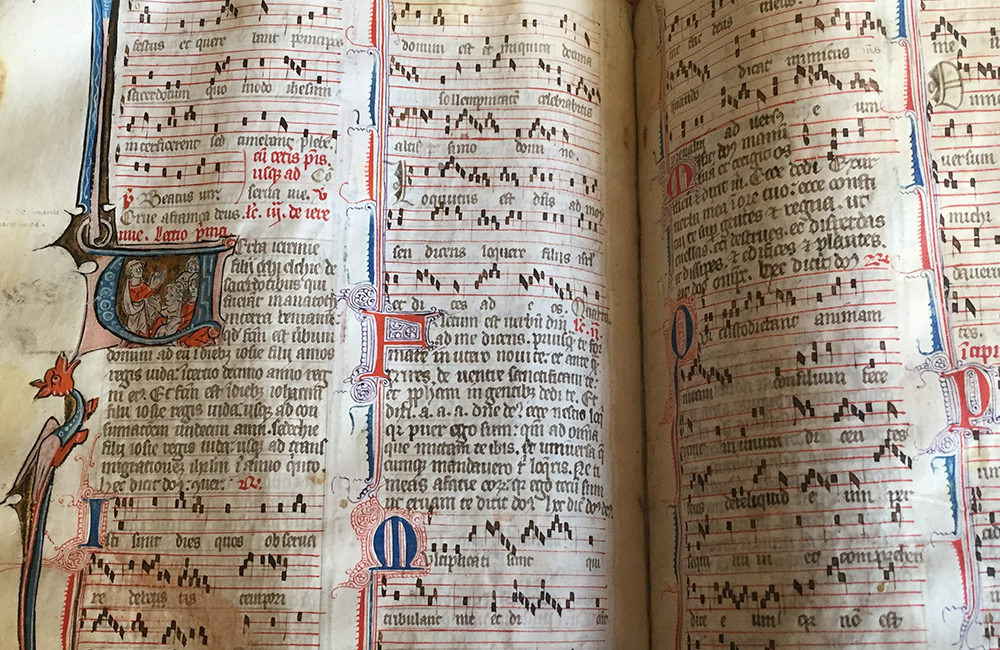
Dom Joseph Pothier is appointed abbot. He was a great restorer of Gregorian chant.
The 1901 law banning religious congregations forces monks to leave. Second exile.
1907-1912 : Belgian writer Maeterlinck occupies the abbey with actress Georgette Leblanc. The couple staged a production of Macbeth in the abbey, followed by Pélléas et Mélisande the following year.
1919 : Maeterlinck sells his lease to aircraft manufacturer Jean Latham.
1931 : Jean Latham accepts the buyout of his lease by the exiled community.
Monks return to Saint-Wandrille
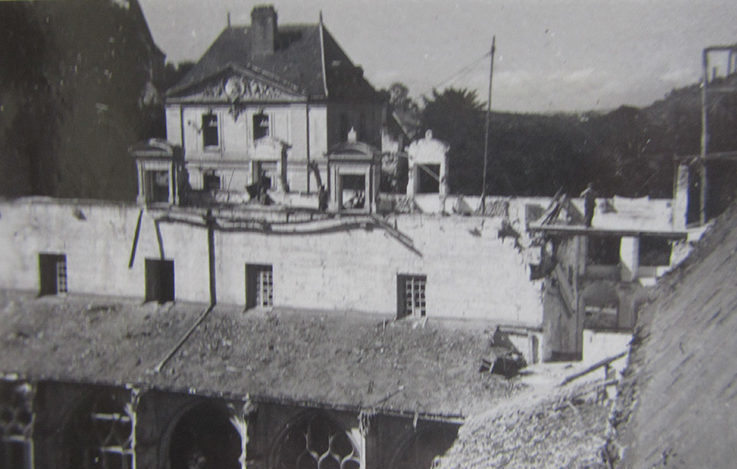
Bombing of the monastery. Reconstruction work lasted from 1948 to 1957.
Construction of the new abbey church.
The community of thirty Benedictine brothers continues this tradition of prayer and work, silence and simplicity. The Most Reverend Father Dom Jean-Charles Nault is the 82nd abbot.
THE PELICAN DOOR
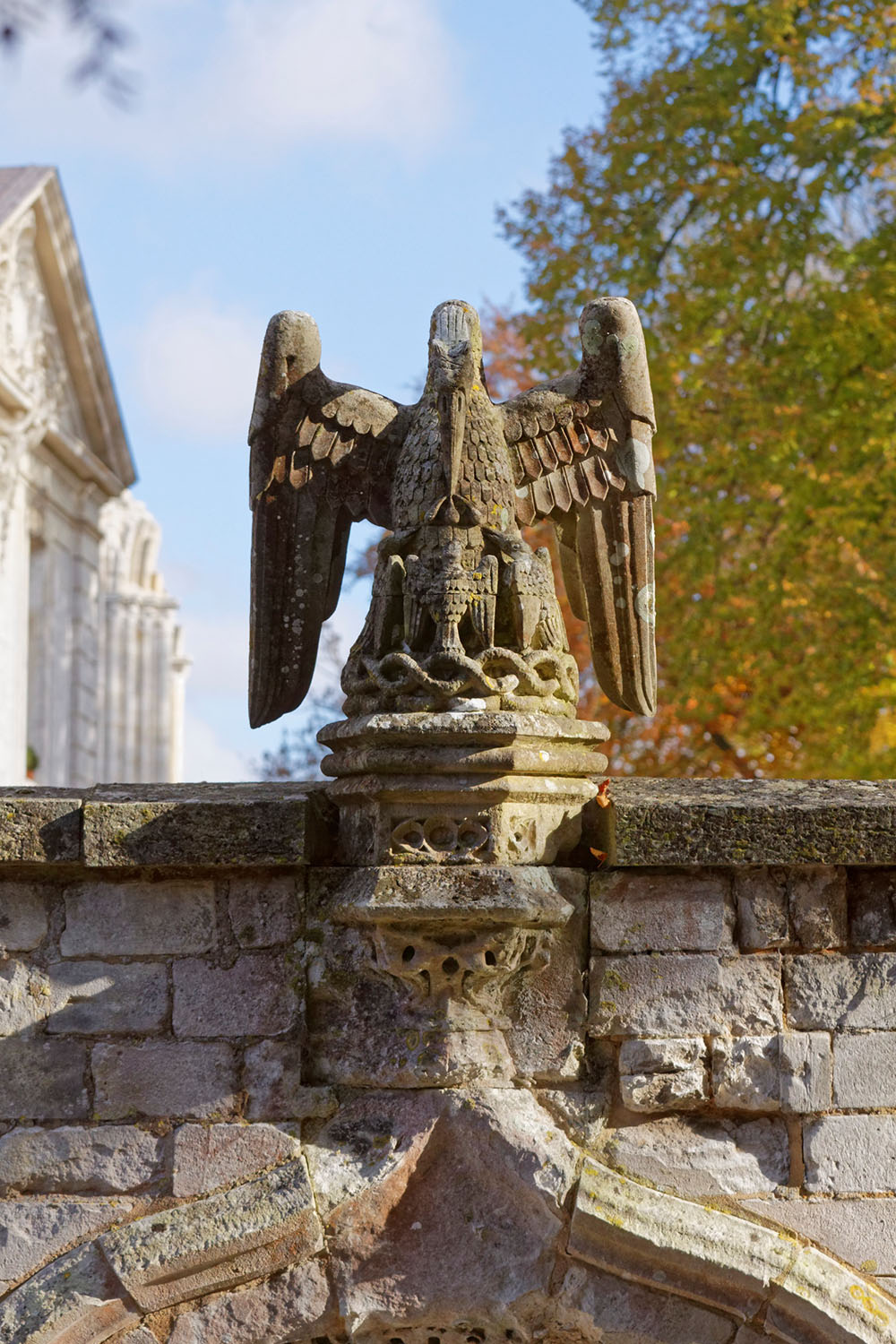
This small arched doorway to the forecourt features a pelican piercing its flank with its beak to feed its young with its blood. It is a symbol of Christ who gave his blood for the salvation of mankind.
WELCOME DESK OF THE ABBEY
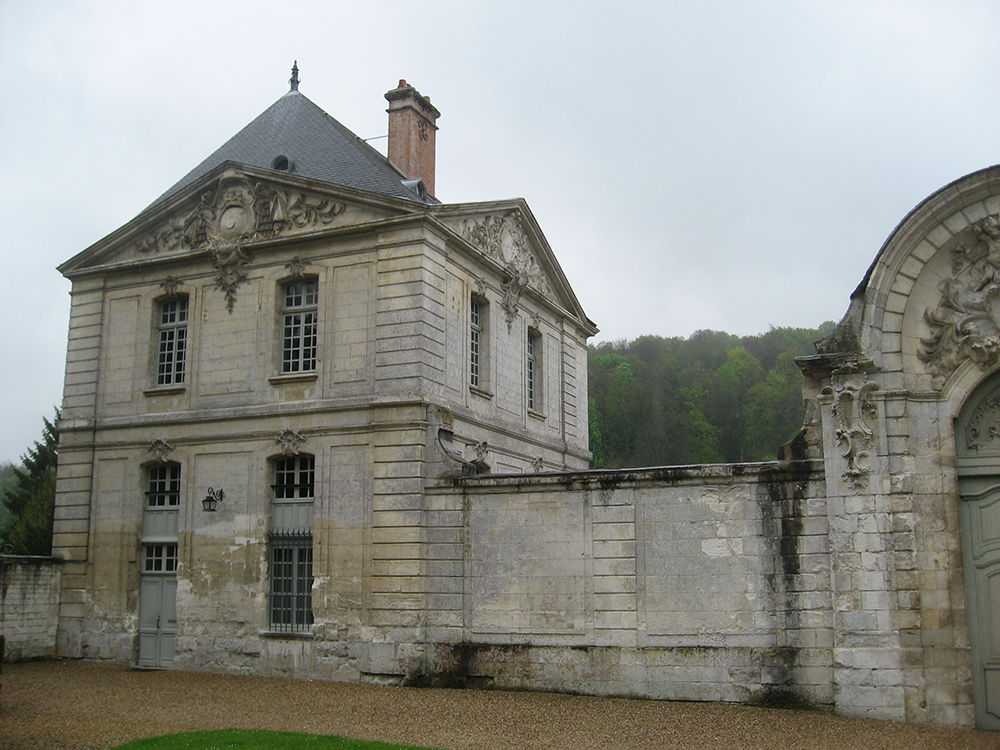
Opening hours:
- 10:45 am – 12:30 pm
- 2:45 pm – 5:00 pm
- 6:45 pm – 7:00 pm
- 9:00 am – 9:30 am
- 11:30 am – 12:30 pm
- 2:45 pm – 4:45 pm
- 5:45 pm – 7:00 pm
JARENTE GATE AND PAVILIONS
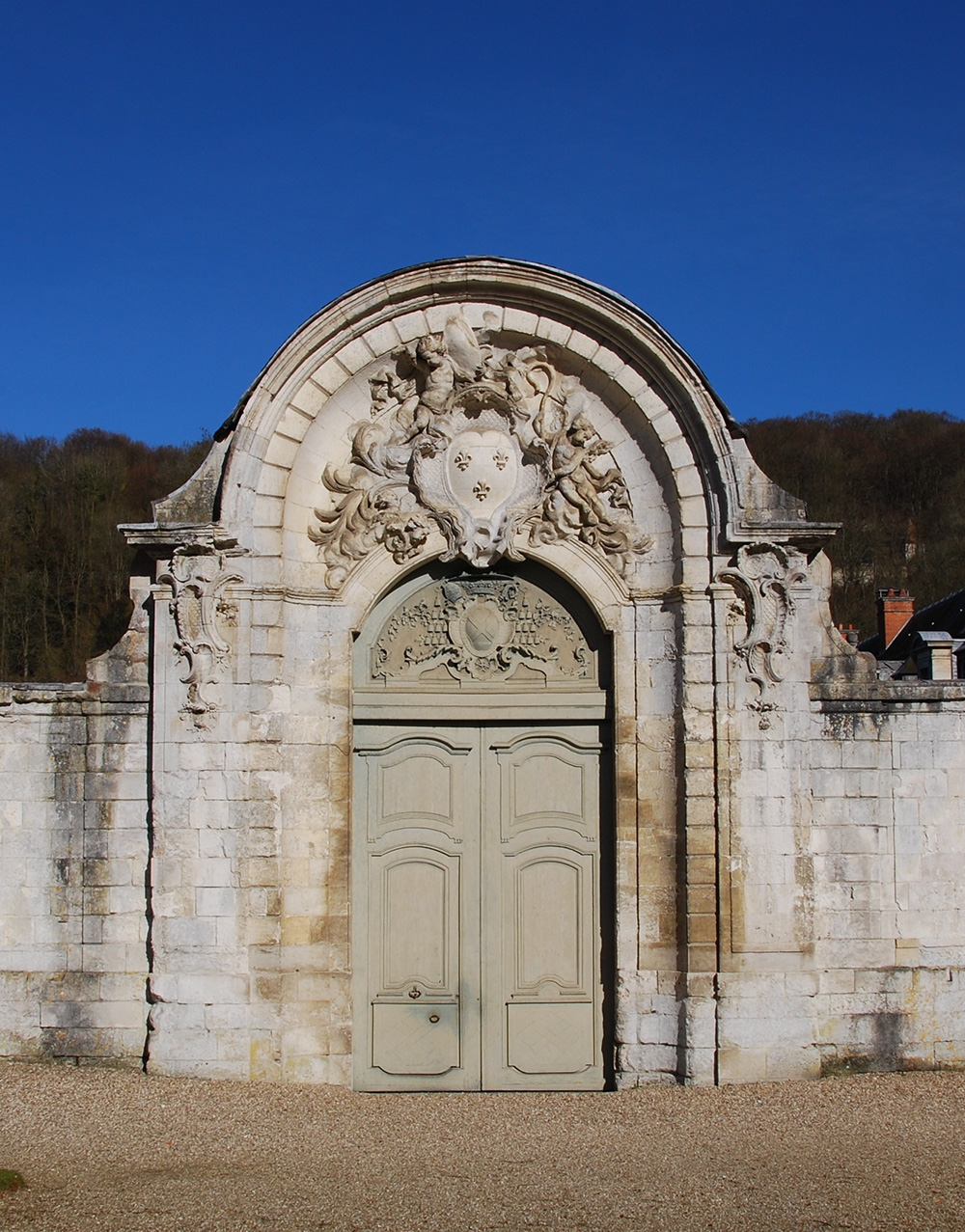
Jarente Gate
This monumental gateway was built during the reign of Mgr Louis Sextius de Jarente, Bishop of Orléans. On the frame of the massive oak door is his coat of arms. On the stone tympanum, angels uphold the abbatial cross and mitre in an elegant decor of palm branches and clouds around the Abbey’s coat of arms. Two pavilions rise symmetrically on either side of this gate.
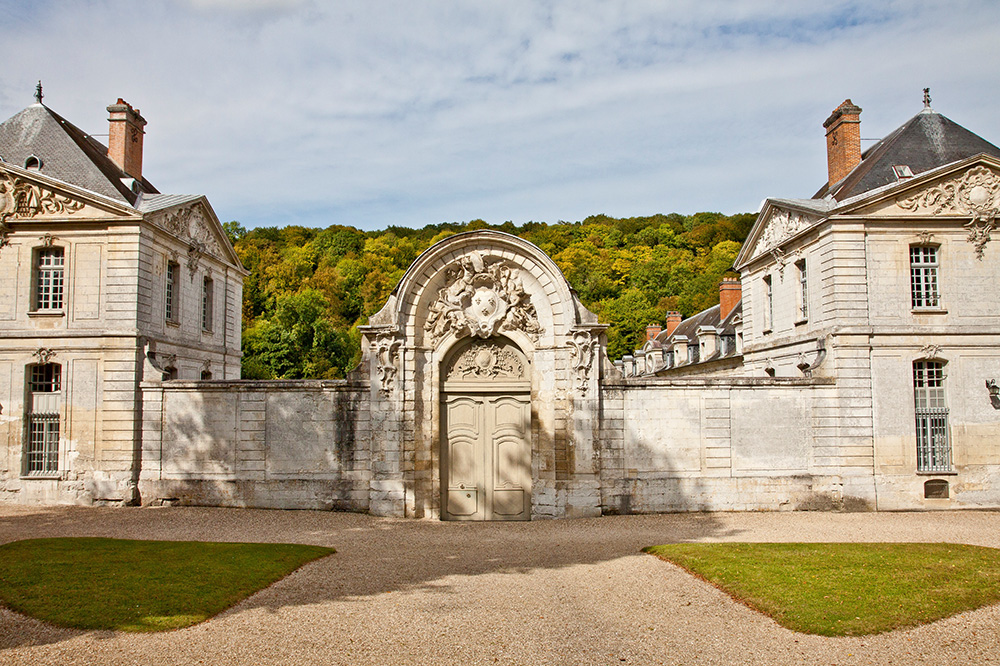
The Pavilion of Nature and The Pavilion of Grace
The pavilion on the left housing the reception and the internal guest quarters of the monastery is called: Of Nature or Of Hospitality.
On the triangular pediment of the south façade, the remains of the coat of arms of the abbot, Cardinal de La Rochefoucauld, can be discerned, whose ducal mantle and prelatic hat were respected by the revolutionaries.
On the façade facing the inner courtyard, the pediment depicts a woman, Hospitality, bowing in a welcoming gesture. She’s holding a huge cornucopia filled with fruit, with a crane dangling from it, symbolizing vigilance.
The pavilion on the right, Pavillon de la Grace (1756), houses the visiting rooms.
The south façade also features a heraldic pediment bearing the coat of arms of the Congrégation de Saint-Maur. In a crown of thorns, above the three Passion nails, is the Benedictine Pax surmounted by a fleur-de-lys.
In the courtyard, we see the Trinity triangle bearing the Hebrew characters of Yahweh’s name, accompanied on the left by New Testament symbols (Christ’s open book, cross and crown of thorns) and on the right by an Old Testament symbol (Moses’ bronze serpent) accompanied by a surprising elephant head evoking piety.
RUINS OF THE FORMER ABBEY CHURCH
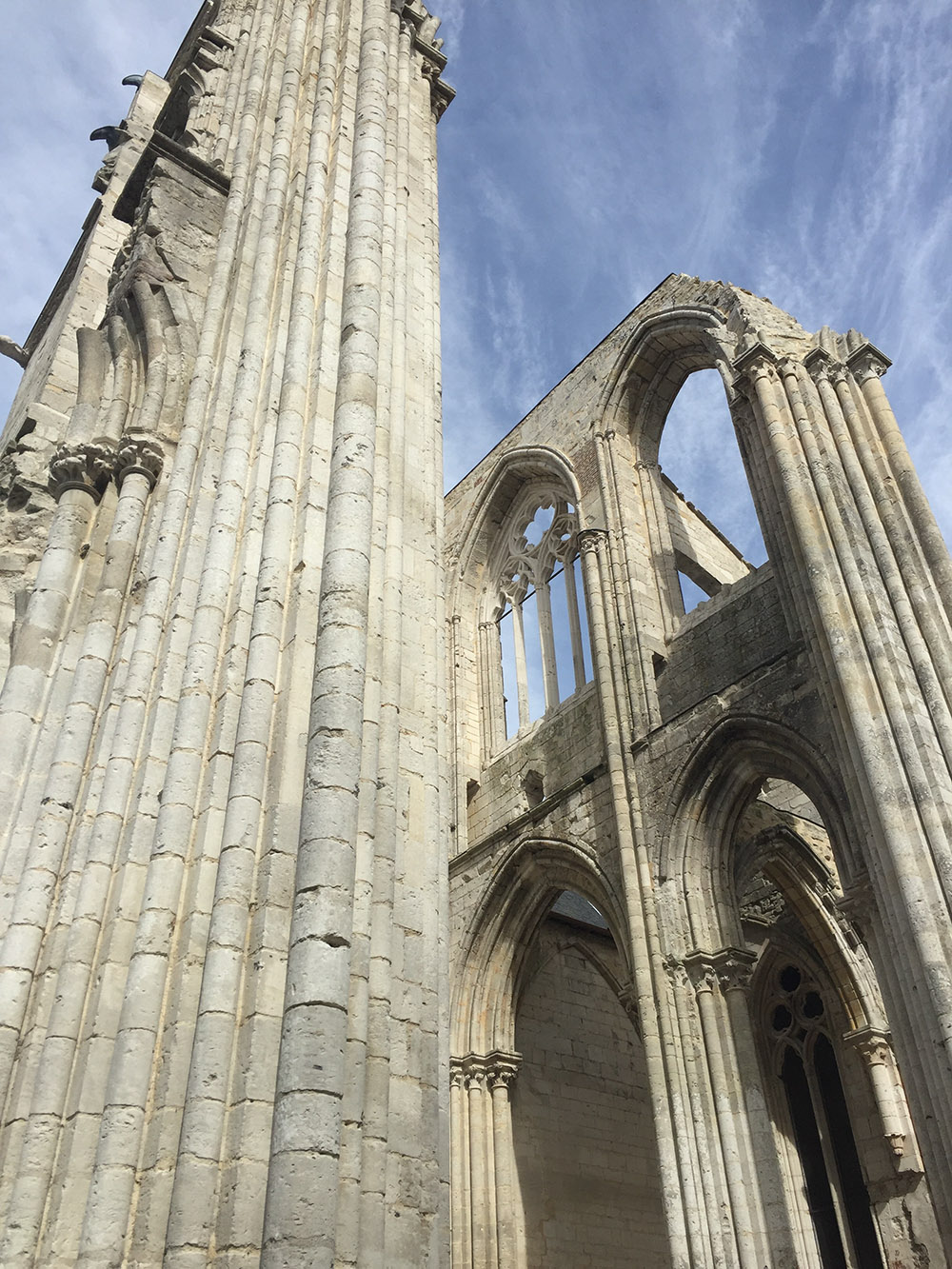
The abbey church has been rebuilt several times on this site.
The first is that of Saint Wandrille (7th c.), rebuilt by Anségise in Carolingian times and destroyed by the Vikings in 852.
When the community returned from exile, Abbot Maynard built a new church (after 960). Entre 1006 et 10029, son successeur, l’abbé Gérard, agrandit l’église avec un nouveau chœur, un déambulatoire et une crypte. This building was destroyed by fire in 1247.
Construction of this Gothic church began in 1249. Its dimensions are impressive: 60m long, 22m50 high under vaulted ceiling, choir surrounded by 14 radiating chapels… Three bays of the nave were never built.
Poorly maintained by the commendatory abbots (the lantern tower collapsed in 1631), it was restored by the monks of Saint-Maur.
After the French Revolution, lay owners used the abbey church as a stone quarry, reducing it to ruins. All that remains is the slender north transept, part of the choir, the north wall of the nave and the base of the columns.
CLASSIC CONVENT BUILDINGS
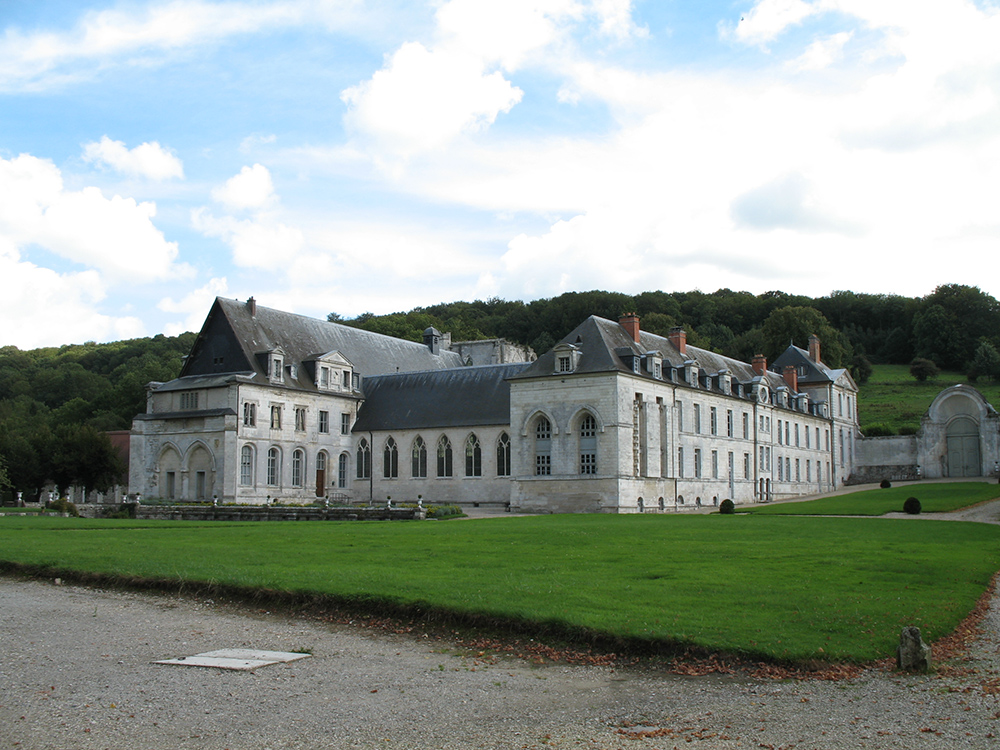
These 17th-century buildings reflect both the majesty of the Grand Siècle and the austerity of the Mauristes: large windows, noble facades topped by high roofs pierced by dormer windows, but devoid of all superfluous ornamentation.
The vicissitudes of history have not spared the west wing. It was extensively modified in the 19th century by the Marquis of Stacpoole, in a neo-Gothic style that can be seen in some of the buttresses. The building also came under heavy Allied bombardment on the night of August 9-10, 1944. The first floor houses visiting rooms, the guest room, kitchen and library, while the upper floors house the cells and novitiate.
The east wing is known as the dormitory building, as the corridors on the first and second floors still serve most of the community’s cells. On the first floor was a 40-meter-long promenoir, divided into 2 naves by a row of 11 columns. Unfortunately, the Marquis of Stacpoole’s desire to change the layout of the building led to its almost total demolition. The two remaining bays now house the community hall.
Elderly and sick brothers are cared for in the infirmary on the second floor. They remain in the monastery, as far as possible, in the midst of their brothers, preparing for the ultimate encounter with the Lord, whom they have come to seek.
LE CLOISTER
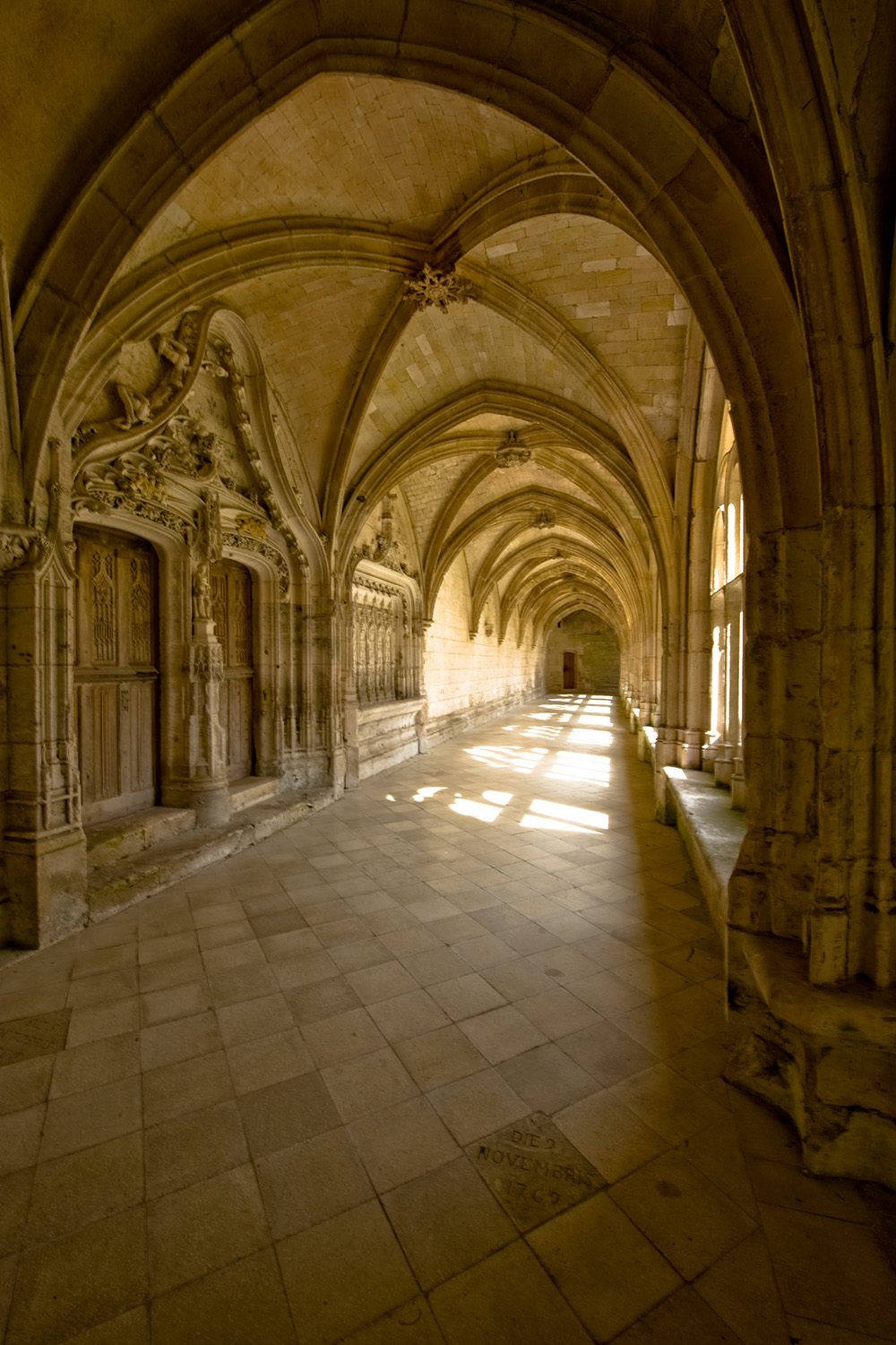
Two ancient cloisters preceded the present Gothic cloister: the Carolingian cloister, built by Abbot Anségise between 823 and 833, and the Romancloister, rebuilt in the first half of the 12th century.
The south gallery, leaning against the ruins of the abbey church, is the oldest. Its construction began in 1249. The statue of the Virgin Mary, Our Lady of Fontenelle, which stands at the east end, dates from the 1300s. The first abbots of the last monastic restoration, Dom Pothier and Dom Pierdait, are buried at her feet. Their tombstones, along with others dating from before the French Revolution, remind us that the cloister has been used over the years as a community cemetery.
The portal linking the cloister to the nave of the church is decorated with a finely sculpted frieze of oak leaves and acorns on the lintel, and rows of ivy and grape leaves between the arches. The central tympanum depicts the crowning of the Virgin Mary by Christ, venerated by two abbots and celebrated by three angels. Unfortunately, all this statuary was mutilated by the Huguenots in 1562.
The other galleries, in the Flamboyant Gothic style, were built in two stages in the late 15th and early 16th centuries. Their vaults are less slender than in the south gallery, supported by ribbed crossbeams rising from piers without capitals. The networks that set the stained glass windows are in a variety of styles: the oldest are in the east gallery, while the others, which are more ornate, date from the early Renaissance period. At the entrance to the refectory, the washbasin combines flamboyant Gothic and early Norman Renaissance art. Two scenes are depicted: the baptism of Jesus, and the risen Christ appearing to Mary Magdalene.
LE REFECTORY
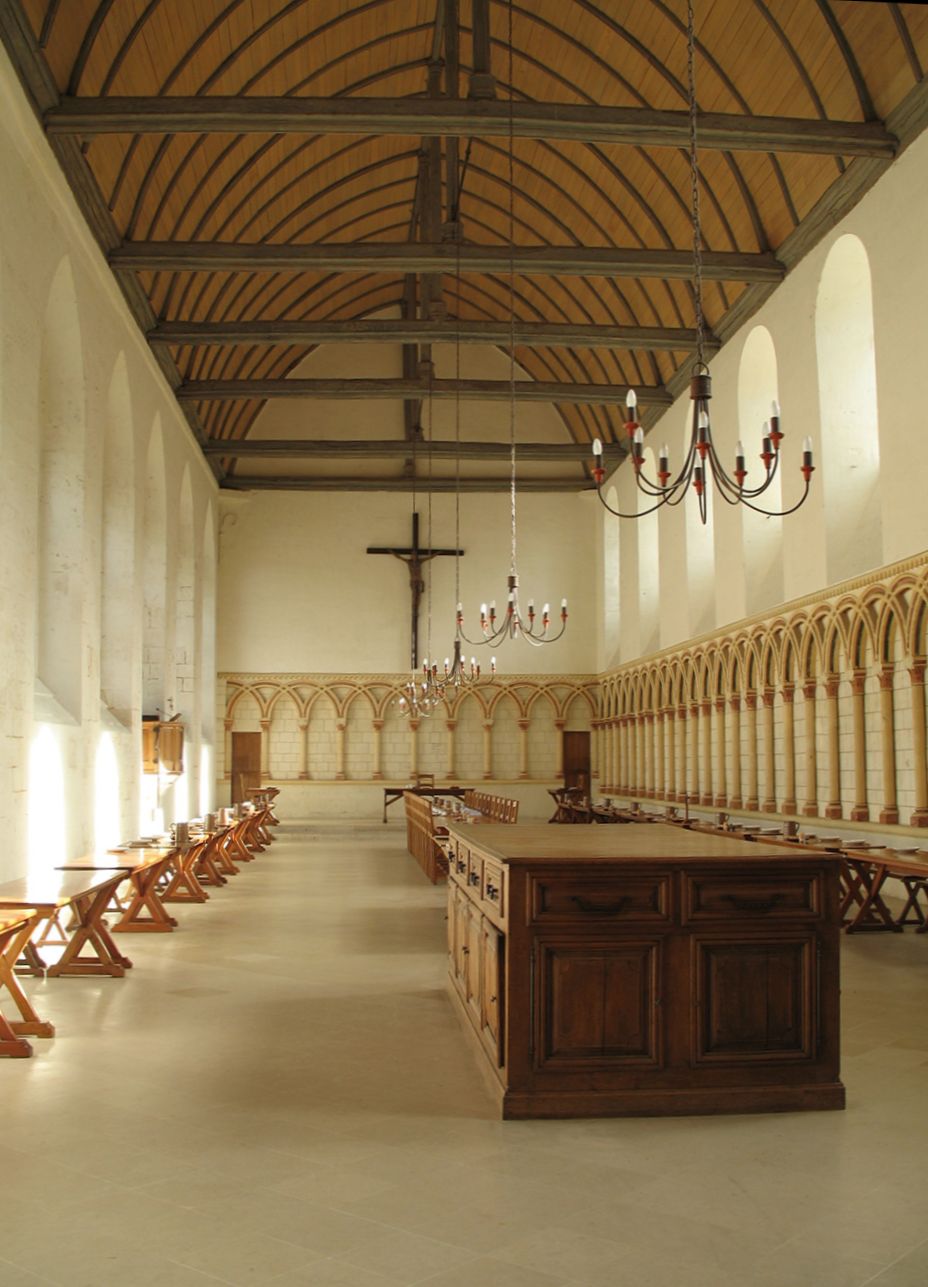
Our refectory is the oldest monastic refectory in Western Europe still in use. It was completely restored in the 1990s.
The nave is 33 m long and 9 m wide. At the base of three of the walls runs a late 12th-century Romanesque arcature whose intersecting arches, falling on columns with flat-leaf capitals, herald the arrival of Gothic art. The north wall is pierced by high windows. The impressive oak framework, in the shape of an inverted hull, dates from the 16th century.
LEARN MORE
A community place
The meal brings the monks together and demonstrates the community’s hospitality. The long table in the middle of the refectory is for guests of the monastery, who share the community’s meals.
It’s also a place for nourishing the mind, as St. Benedict insists that “reading is never lacking at the brothers’ table”. Meals are therefore taken in silence, with only the voice of the lector seated in the pulpit to be heard. During meals, the monks listen to the Bible and the martyrology (brief summaries of the lives of the saints celebrated each day of the year), as well as a wide variety of other books, often history or biography at midday, and more spiritual subjects in the evening.
Finally, the refectory is a place of fraternal service: “No one,” says Saint Benedict, “shall be exempt from kitchen service, for there one acquires more charity.”
THE CHAPTER HOUSE
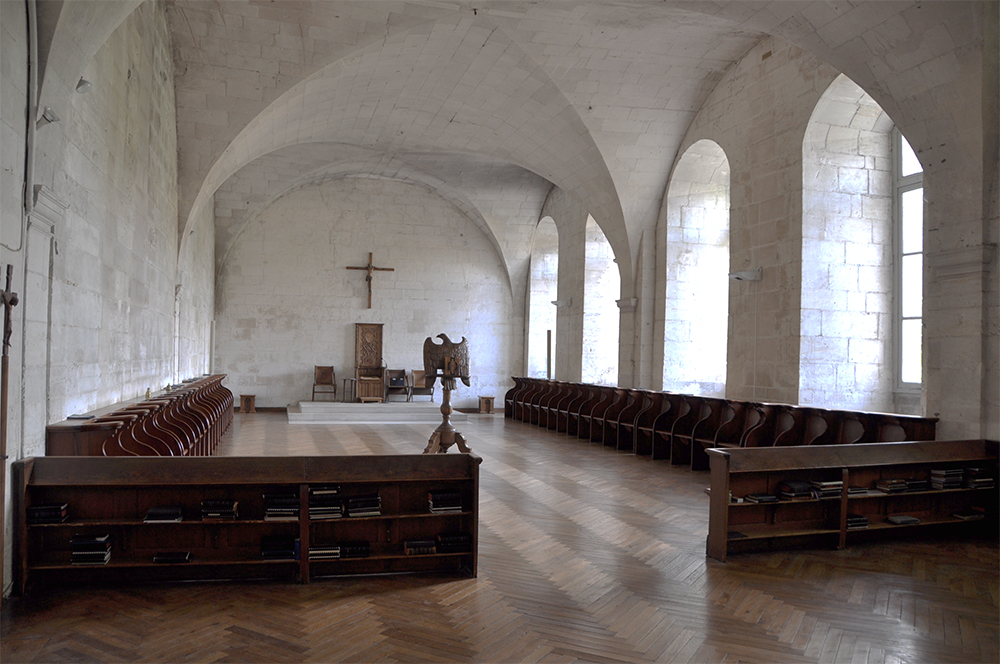
For Benedictine monks, the chapter house is above all a place for listening.
Every day after vespers, the monks listen to a chapter of the rule, which is then commented on by the abbot.
It is also a place for listening and fraternal exchange on subjects affecting the life of the community. For certain decisions, brothers are called upon to vote: election of the abbot, admission of a novice to profession, administrative or financial matters.
Finally, the brothers gather in the chapter house every evening before Compline for a short spiritual reading.
LIBRARY
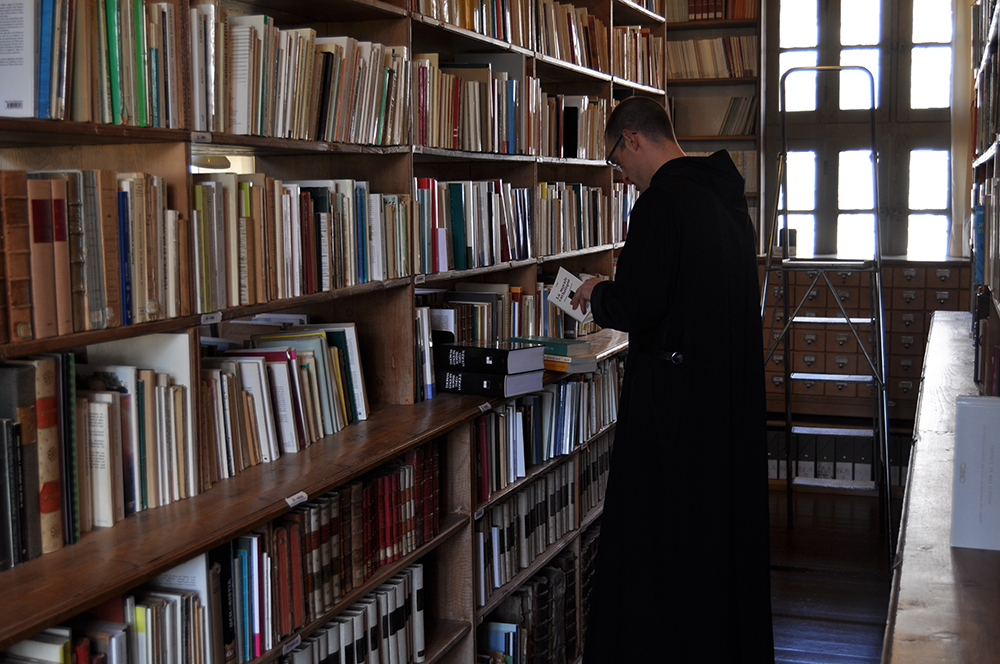
The library is a monastic tradition. Lectio divina is at the heart of monastic life, and monks have always copied and worked on manuscripts. It is thanks to the abbeys that many works, particularly from antiquity, have survived.
Our collection comprises almost 200,000 books. These books, acquired over the centuries, are of the highest quality. Two holdings in particular characterize our library: a regional Norman collection and a musicology collection, notably on Gregorian chant. But we also have a wealth of books on the sacred sciences (whether theology, exegesis, patrology or scholasticism), as well as on the secular sciences, the fine arts, French and foreign literature, the history of religions, philosophy and history.
Nearly 50,000 of these works are already listed on a computer file, and the work continues. This directory will enable us to share our holdings with other libraries and research institutes.
ABBEY CHURCH
SAINT-PETER AND SAINT-WANDRILLE
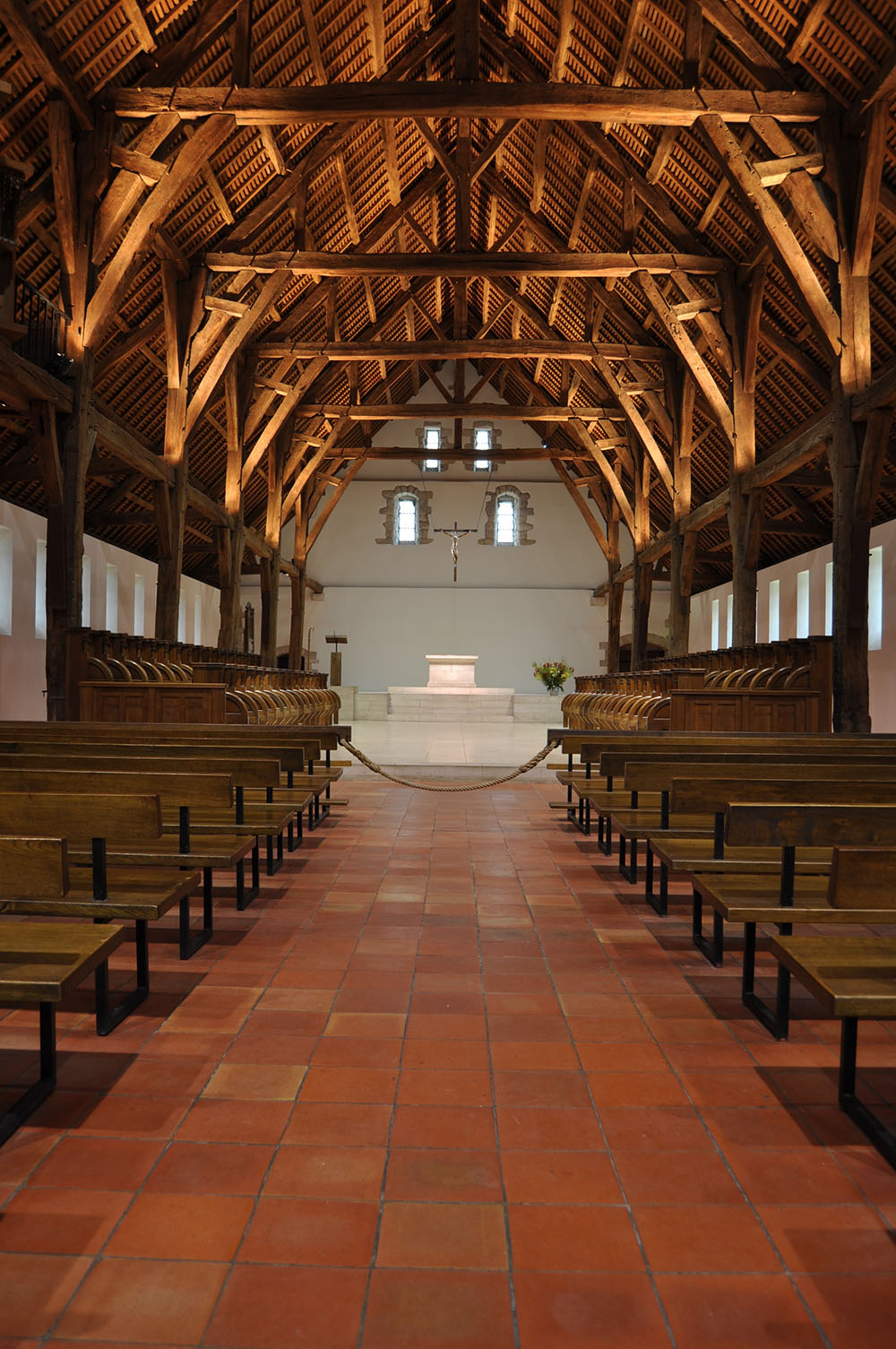
As restoration of the Gothic church proved impossible, the monastery acquired a 13th-century grange at Canteloup near Neuville-du-Bosc (Eure). Dismantled in 1967, it was transferred to its current site thanks to the generosity of the Association des Amis de l’Abbaye. The foundation stone was laid on March 1, 1968, and the church consecrated on September 12, 1970.
The building is 48m long, 16m wide and 14m high. The oak frame dates from the 15th century, the original having been destroyed by fire during the Hundred Years’ War. The chapel of the Blessed Sacrament was built on the south side in what was once the half-timbered porch of the grange.
The organs, built by Haerpfer-Erman (Moselle), have twenty-four stops, three manuals and a pedalboard. They were inaugurated on May 9, 1976.
A precious relic of Saint Wandrille, his skull, is kept in a reliquary on the left side of the choir.
The statue of the Virgin and Child was cast in the 19th century at the Val d’Osne foundry (Haute-Marne). The original 14th-century statue, from the Abbey of Blanchelande, was the first French medieval statue to be acquired by the Musée du Louvre.
In the enfeu, at the back of the church, you’ll find a beautiful tombstone dating from 1506, completely restored in 2011.
OUR LADY OF CAILLOUVILLE
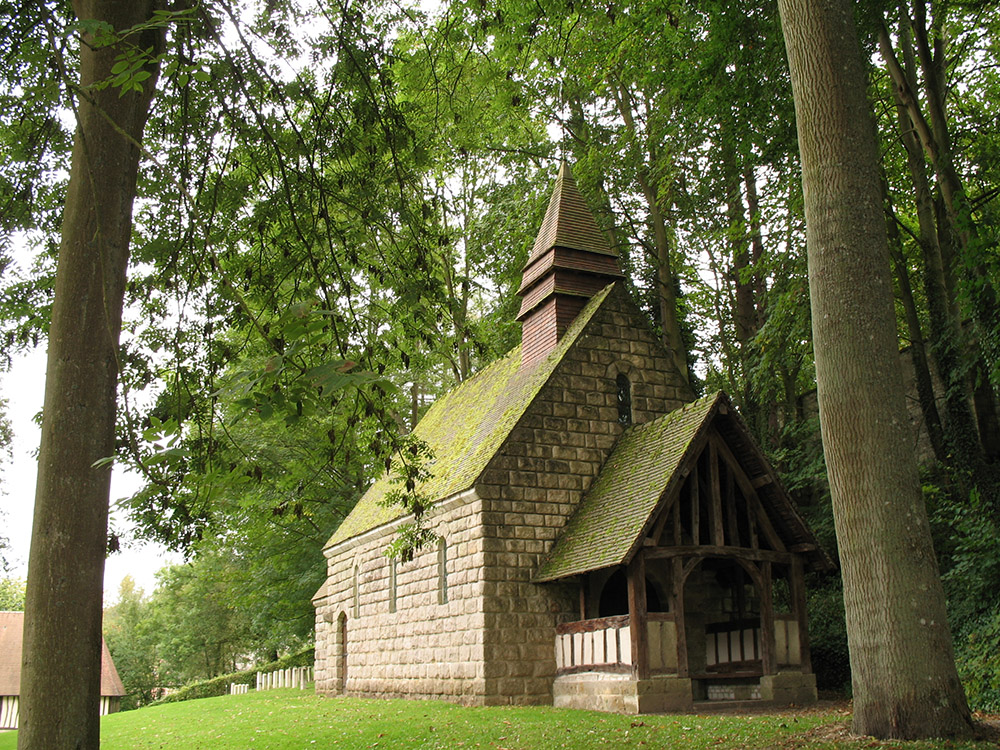
The construction of this chapel dedicated to Our Lady was decided following a vow made by Abbot Dom Gabriel Gontard on August 15, 1944, after the monastery had been bombed. From 1952 to 1958, the brothers built it with their own hands. It was consecrated on June 16, 1977.
This oratory consists of a simply framed nave, preceded by a porch, and a choir with a flat chevet. A small bell tower tops the lower part of the nave.
The stained glass windows depict Notre-Dame des Anges, Saint Wandrille healing his adversary at the Fontenelle springs, and Dom Gontard and his monks offering the votive chapel to the Virgin.
Dom Gontard (+1986) is buried in the nave.
MONKS’ CEMETERY
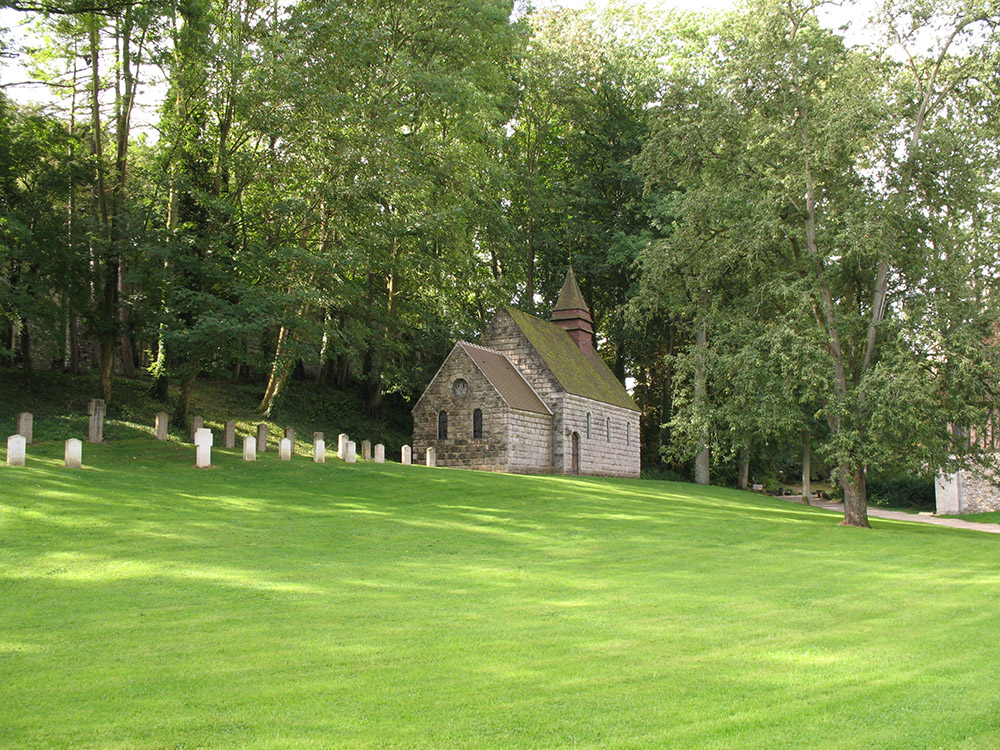
The new monks’ cemetery is an extension of Our Lady of Caillouville. Brothers who have died since 1972 are buried here.
The old cemetery is in the park, on the hillside.
WORKSHOPS – SHOP – BREWERY
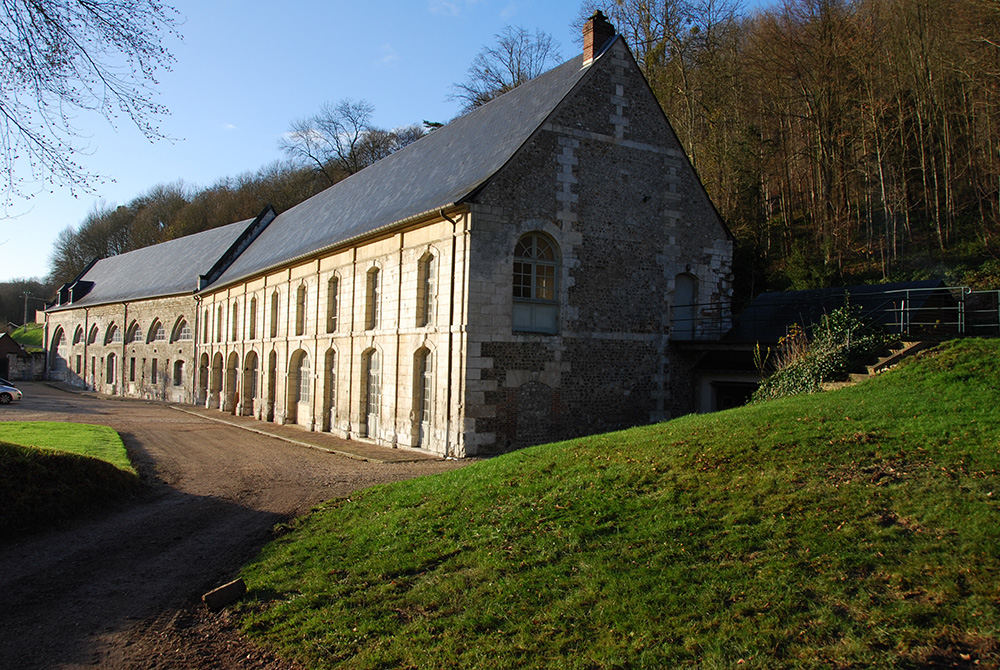
The outbuildings are located beyond the Fontenelle at the foot of the wooded hill. The architecture reveals two periods of construction.
To the west, the 14th-century barn originally had eight bays, divided by massive pillars into a nave and aisle. The Mauristes removed the aisle when they extended the building eastwards in 1699, to install sheds and stables. The only part that remains is the nave, with the columns set into the masonry of the outer wall. The arcades between the columns have been partially uncovered. This was the site of the Melitta encaustic factory. This part of the building was severely damaged by a violent fire in 1954. It was raised a few centimetres during reconstruction.
At the far end of the building, the garages occupy the site of the medieval bakery, probably destroyed by the Marquis of Stacpoole when he redesigned the entrance to the park in the 19th century.
Place of work
Today, the buildings house the community’s economic activities: boutique, painting restoration workshop and brasserie.
SAINT-SATURNIN
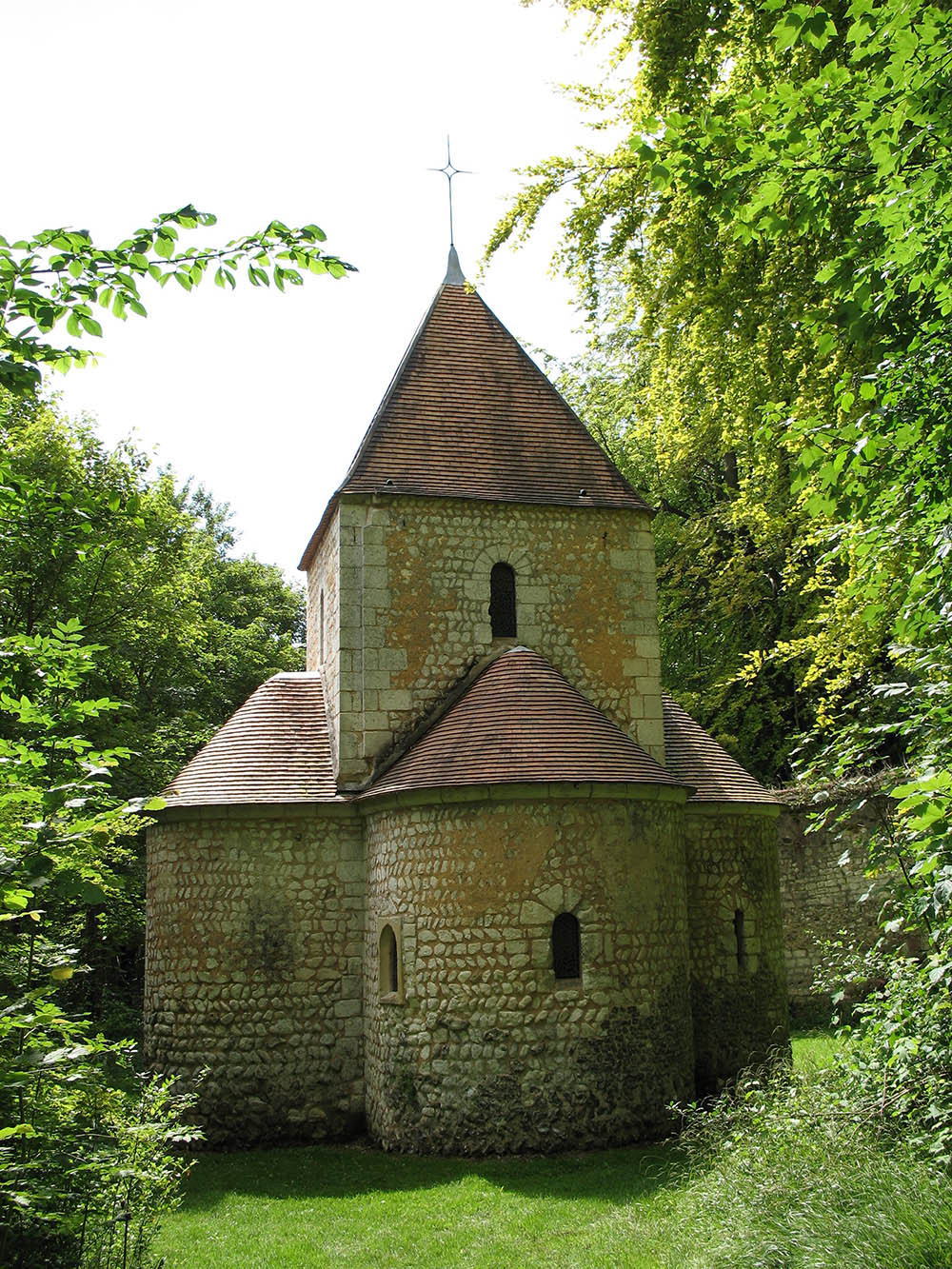
The Saint-Saturnin chapel stands at the very top of the monks’ park. It was built at the end of the 10th century on Carolingian foundations, on the site of a small basilica built by Saint Wandrille himself. A short nave with a frame roof precedes a trefoil choir with three barrel-vaulted apsidioles. At the crossing, a square lantern tower illuminates the choir. Only the transoms of the piers supporting the tower are carved.
STACPOOLE DOOR
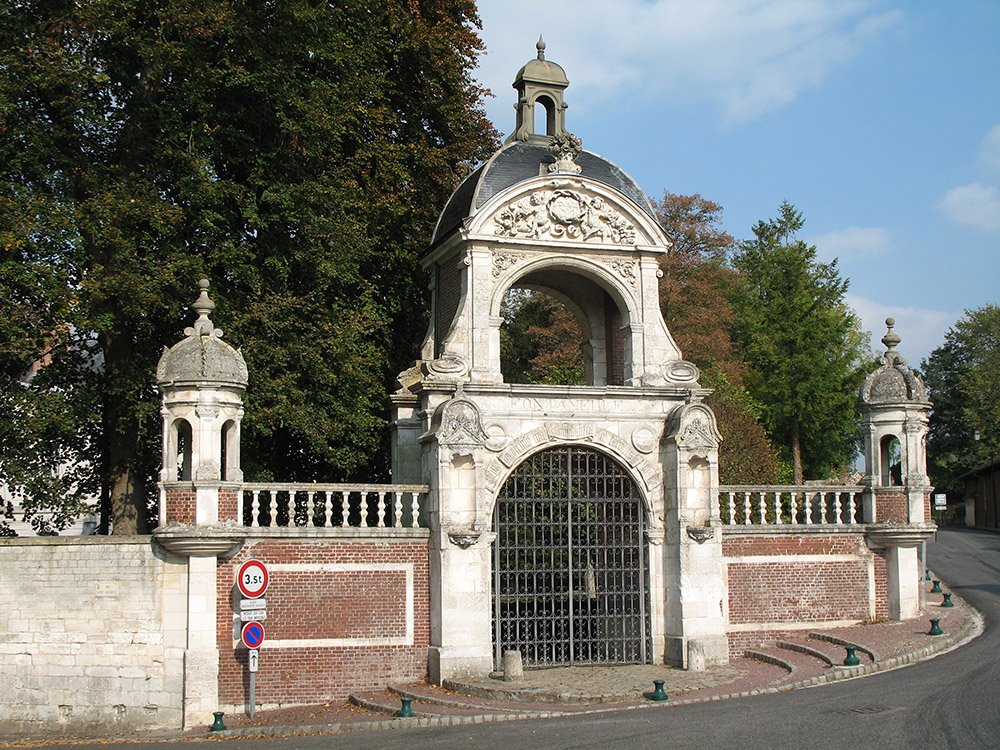
When the Marquis de Stacpoole built the monumental gateway to the village square around 1865, he had a pediment reused from the dormitory building he had just demolished. This 1680 sculpture features the arms of the Saint-Maur congregation.
The Association
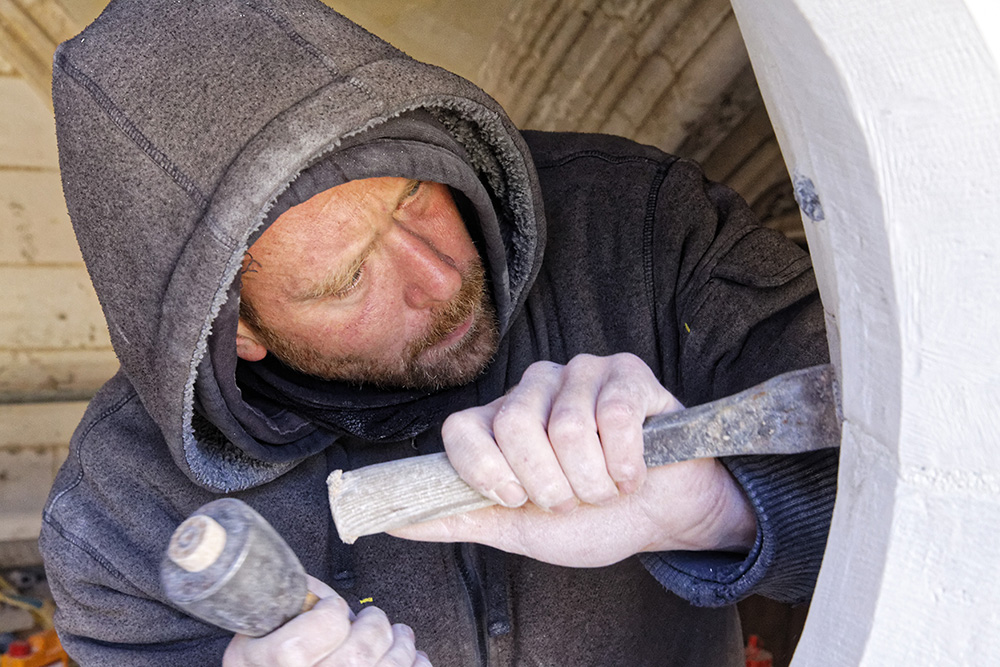
The friends of the Abbey Association is a group of more than 300 members who give both moral and financial support to the community. Notably, they help in projects of restoration of our buildings. Always with the perspective of welcoming greatly all who come, large in number, drawn by the sign of a community of men completely given and dedicated to the service of God.
The Contributions are:
– Benefactor: starting from 75 euros
– Titulaire: starting from 25 euros
– Subscriber: starting from 5 euros
If you would like to become a member of the association, choose the method of payment you would like to use. Complete the formula which will be given to you online, if your payment is by credit card or print out a formula, if you choose to register by check. Then, follow the instructions which are given.
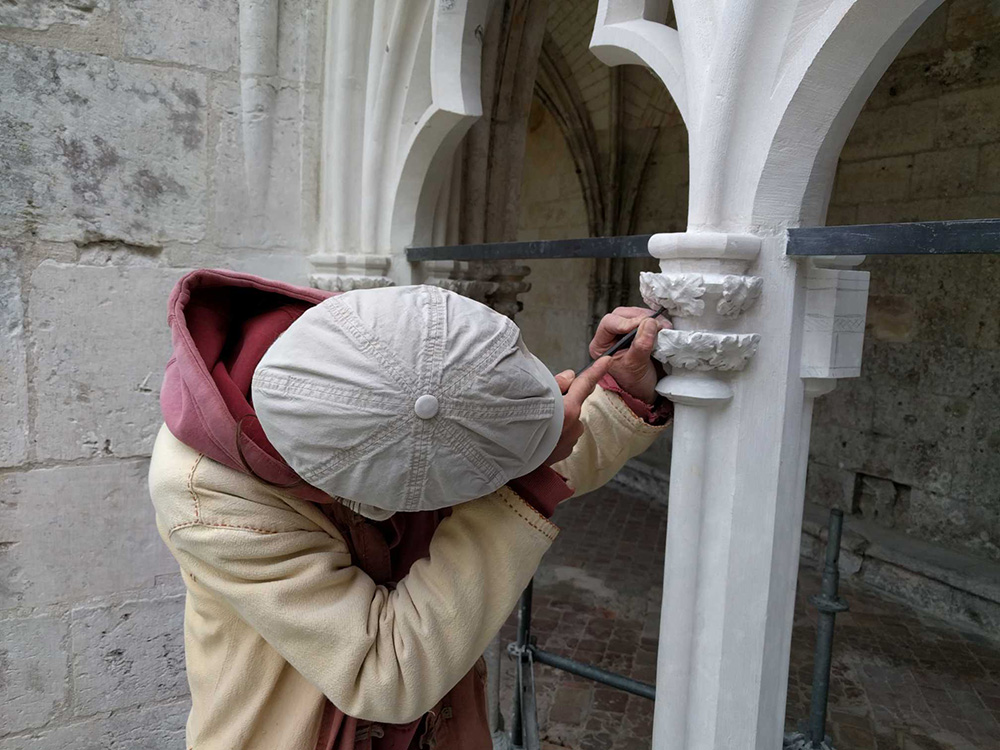
Under current French legislation, membership fees are tax-deductible up to 66% of the amount of the donation, up to a limit of 20% of taxable income We’ll be happy to send a tax receipt corresponding to their contribution to any Friends who request one.
Gesta magazine
GESTA is the title of an account of the first two centuries of Saint-Wandrille Abbey, written by one of its monks around 840. The Gesta, or deeds of the holy fathers of the Fontenelle monastery, is the oldest monastic chronicle in the West.
Each issue of this forty-eight-page quarterly features:
– the chronicle of the monastery, the fabric of our monastic life, which guests, faithful and tourists come to share in their own way,
– a homily delivered at the abbey,
– two or three articles by monks or authors we’ve invited to write about monastic spirituality, Sacred Scripture, episodes in the life of the Church today or in the past, local or more general monastic history, reflections on and in-depth study of major texts of the Church’s Magisterium, reading notes on works dealing with religious life or the Church in general.
By subscribing, you demonstrate your friendship and interest in the life of our community. You’ll share in the richness of our Christian heritage and monastic charism, better understanding and deepening the spiritual challenges of our religious presence.
You expand our circle of friends by supporting our publication.
The annual subscription (4 issues per year) costs €22 (outside the European Union: €24). All our subscriptions run from January to December. On receipt of your payment, we will send you the issues already published, unless you request that your subscription start next year.
Subscription to Gesta magazine:
If you would like to subscribe, please select the payment method you would like to use. Complete the formula which will be given to you online, if your payment is by credit card or print out a formula, if you choose to register by check. Then, follow the instructions which are given.
